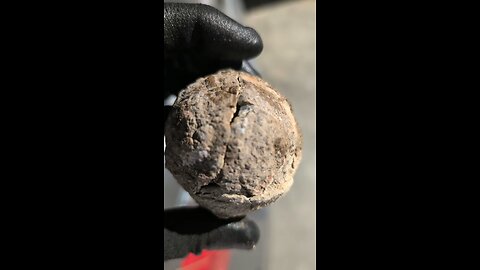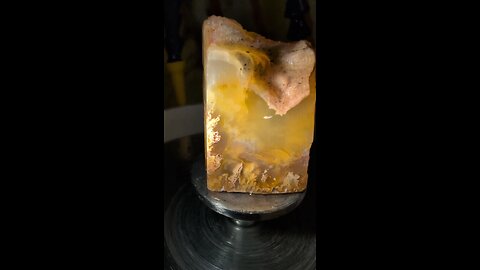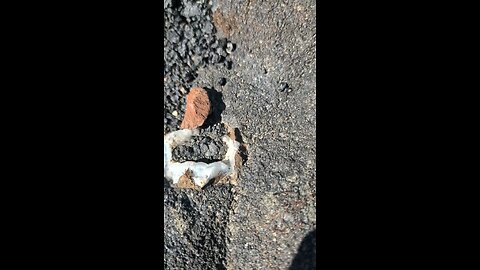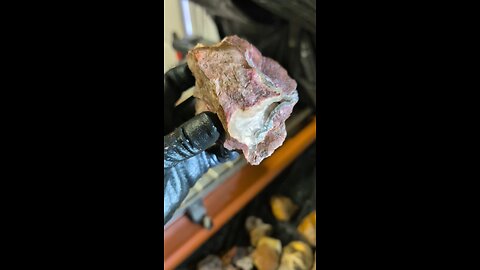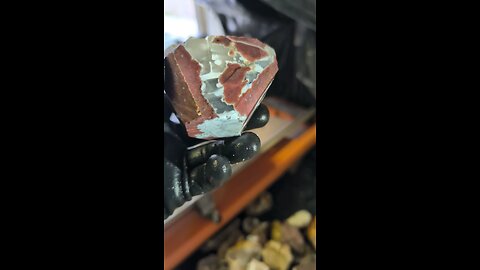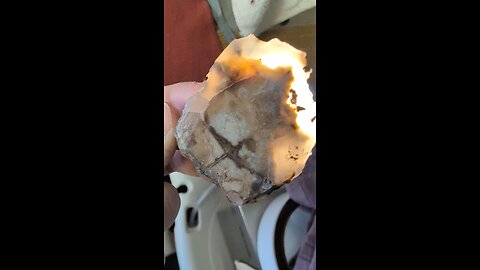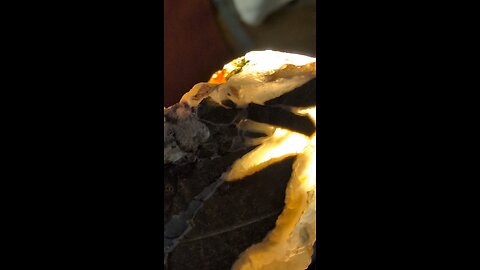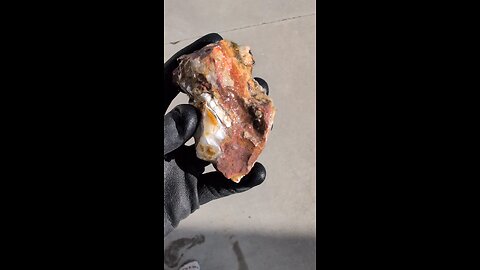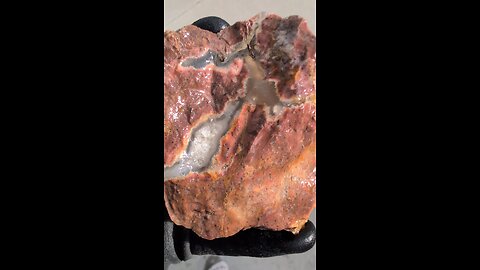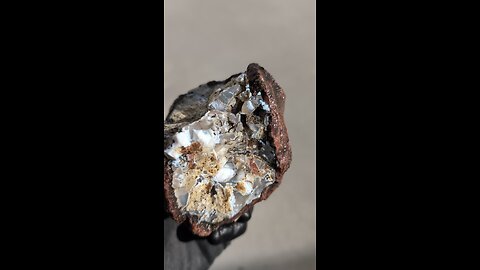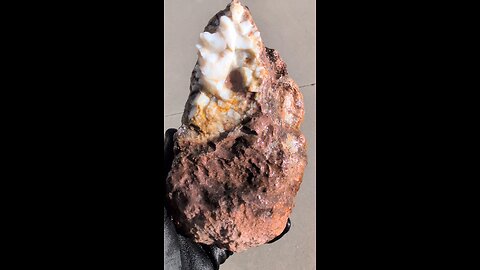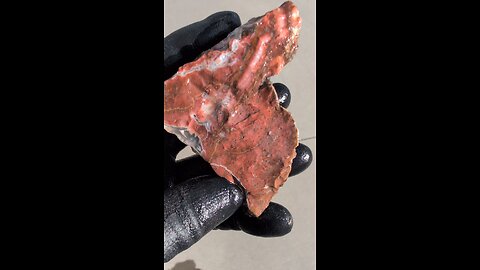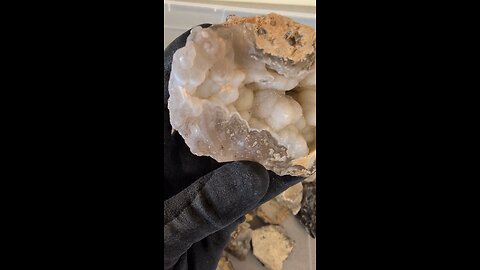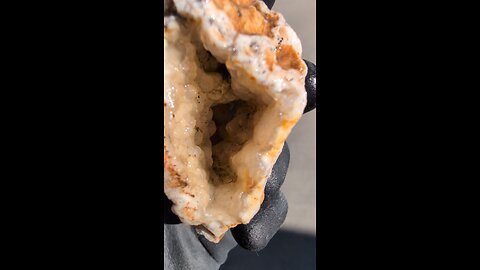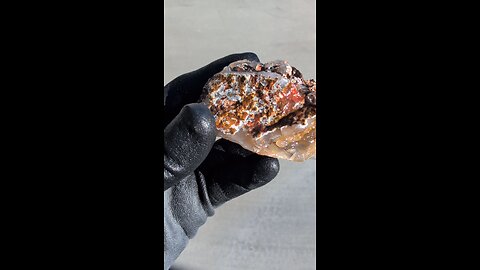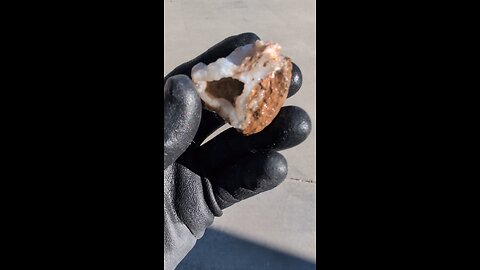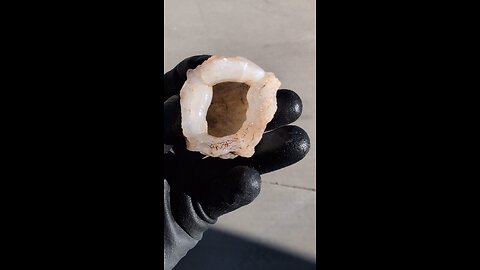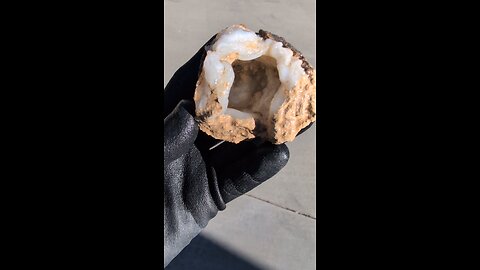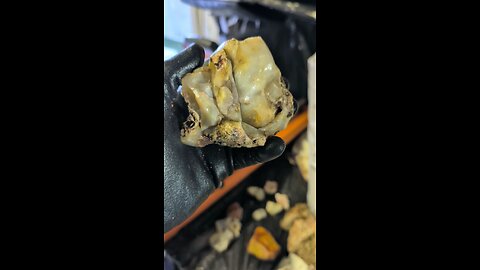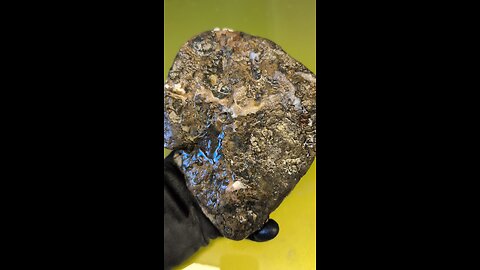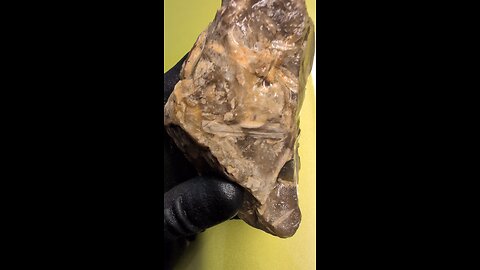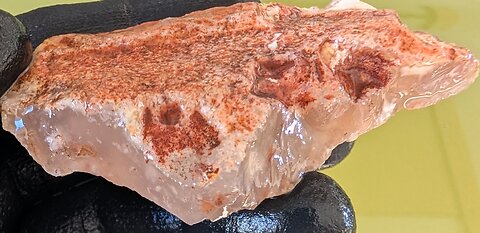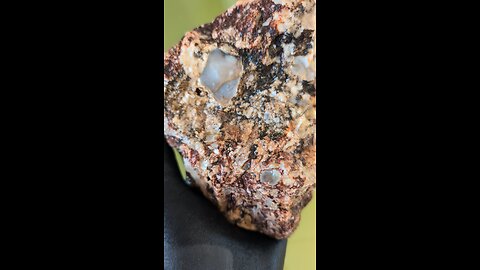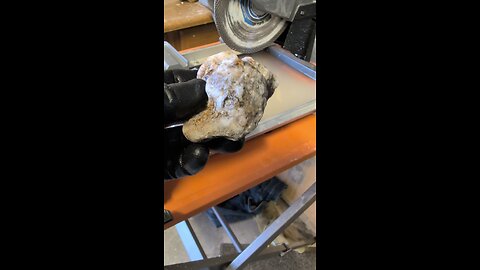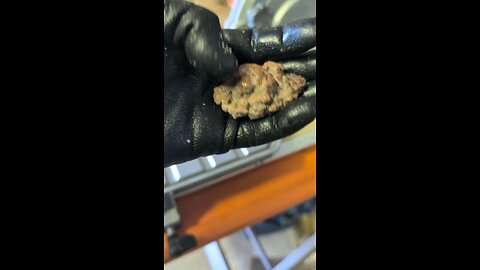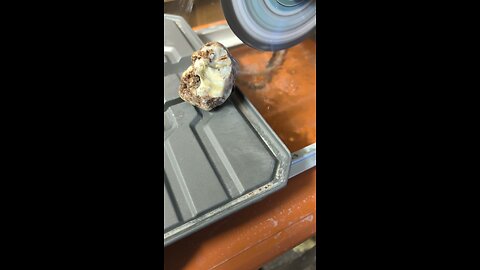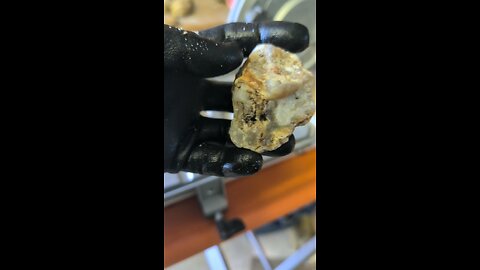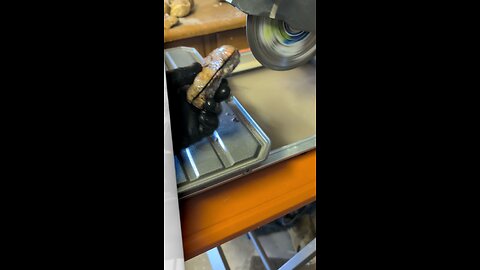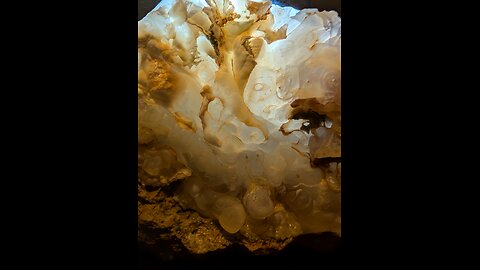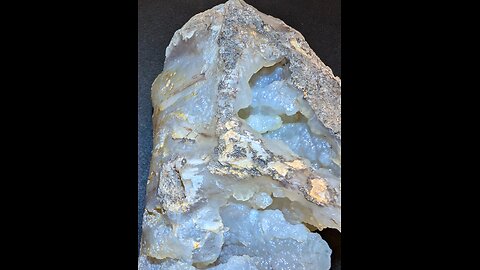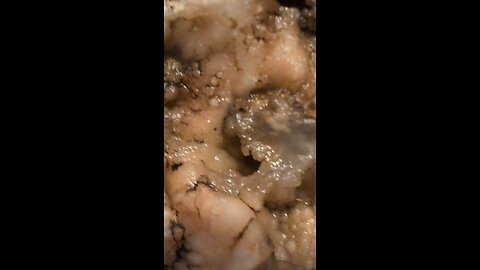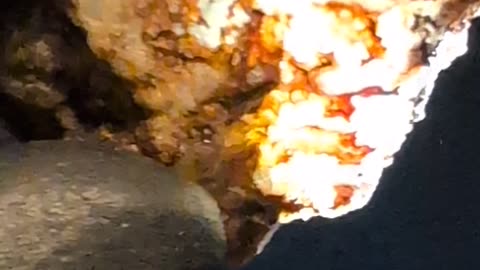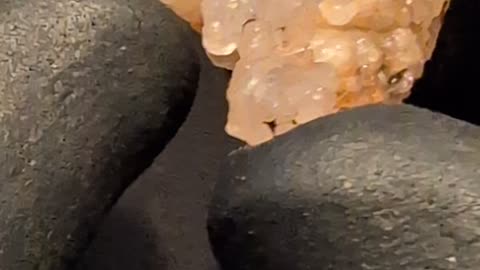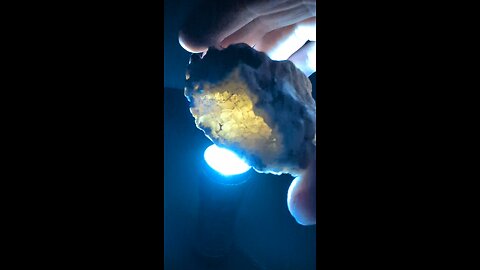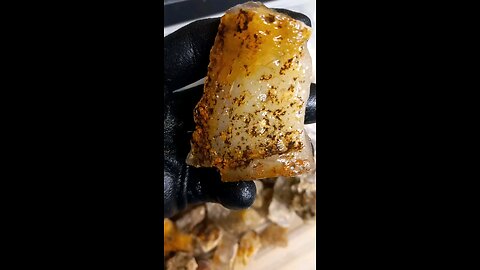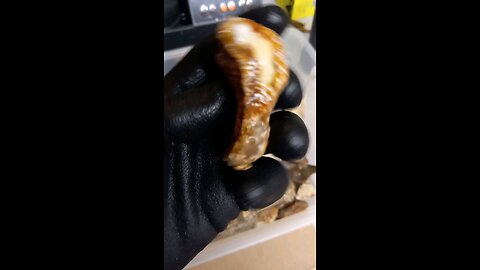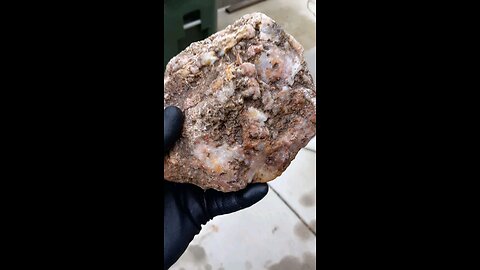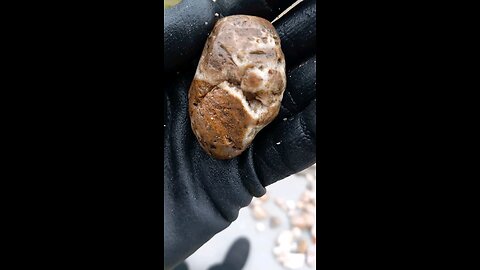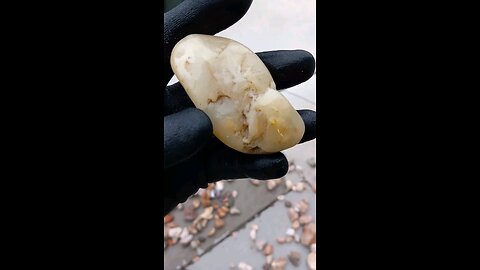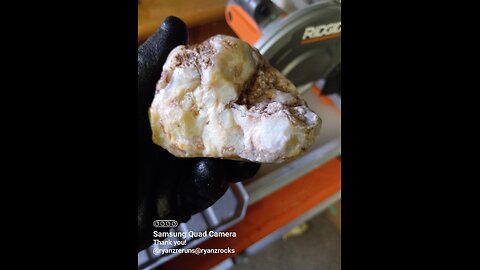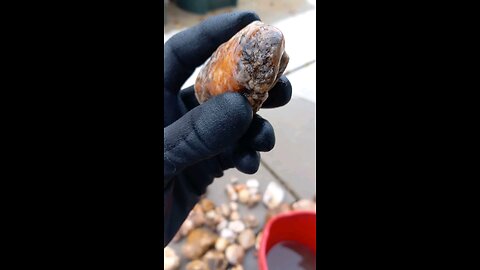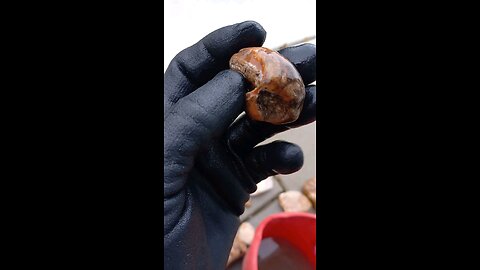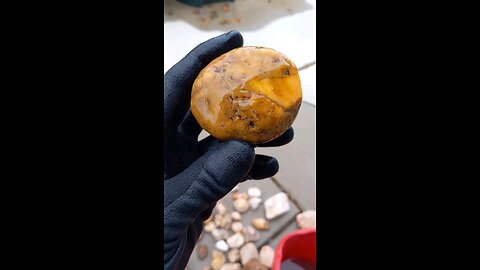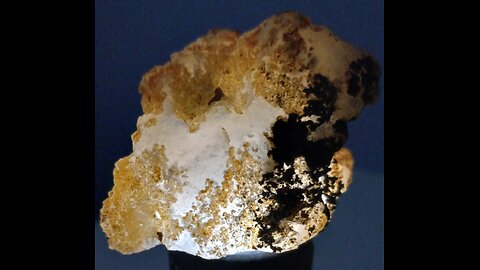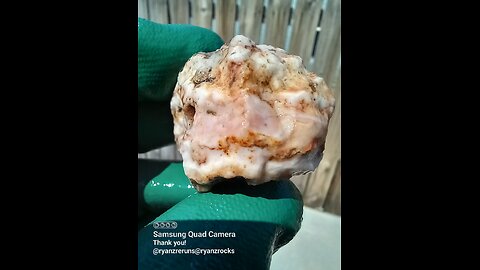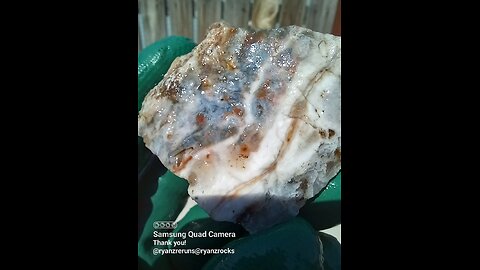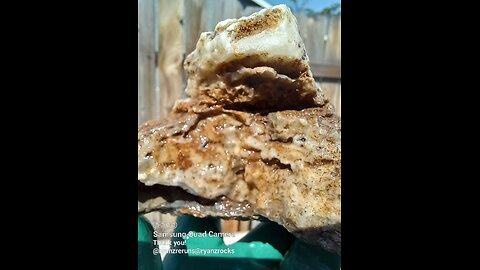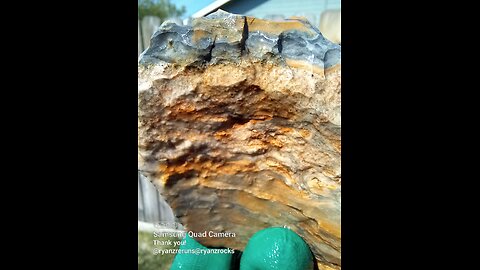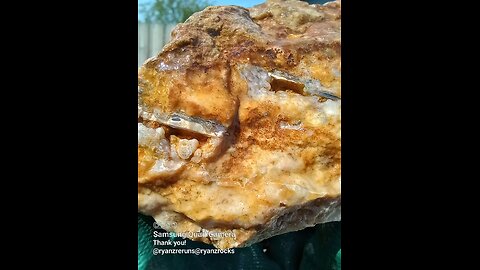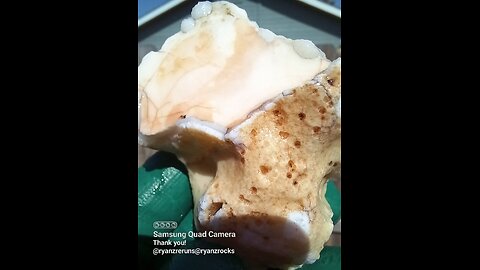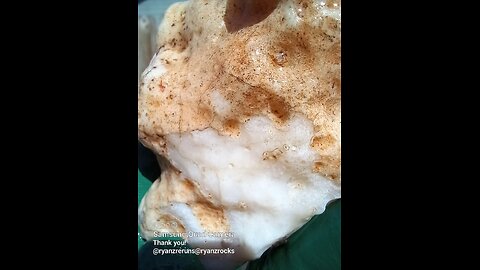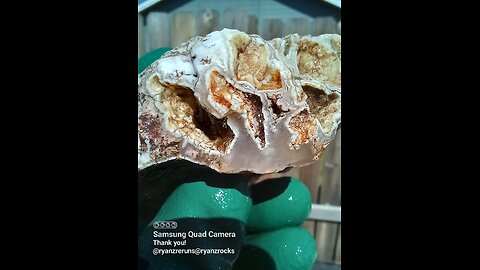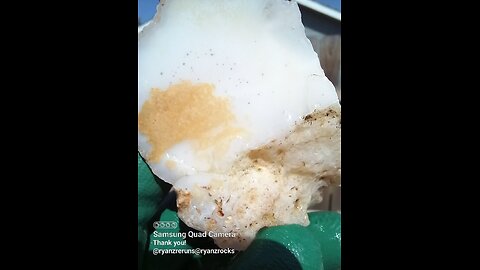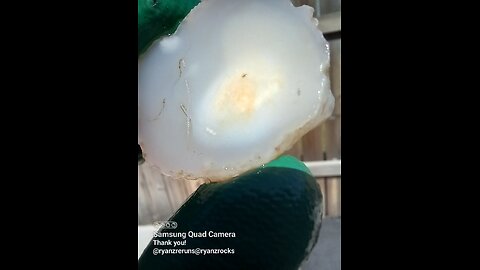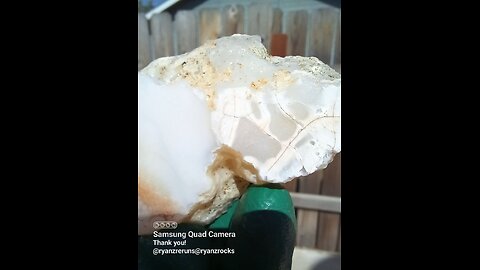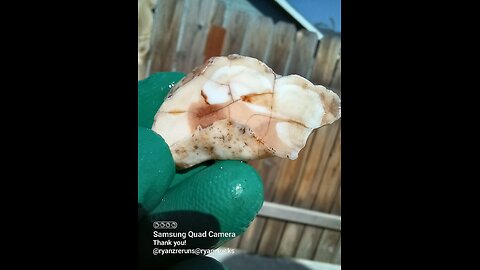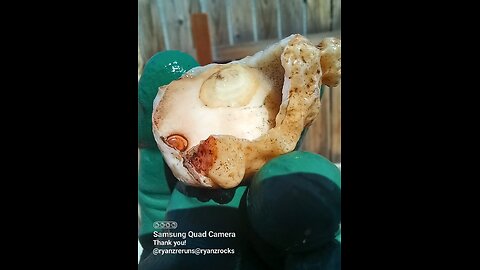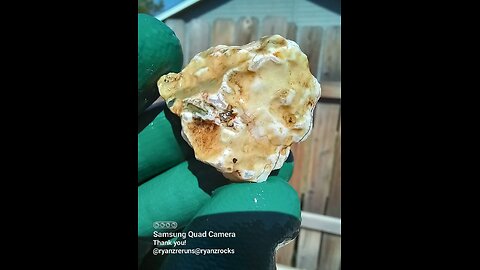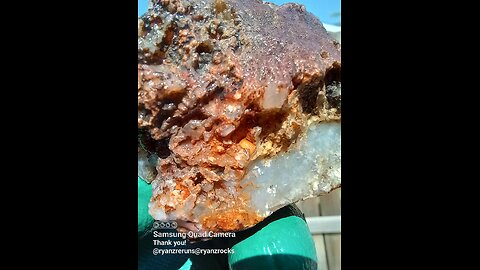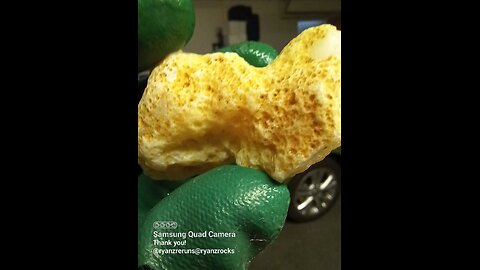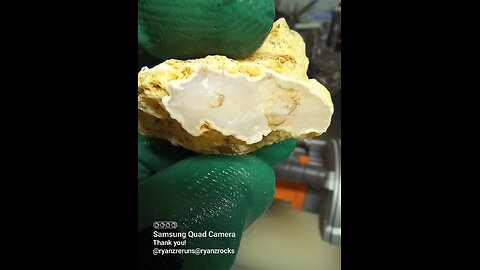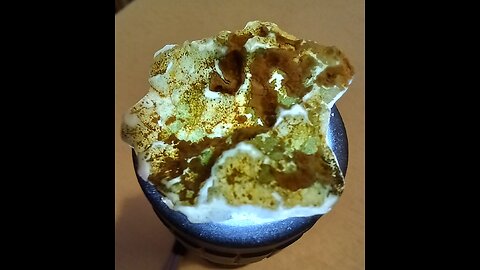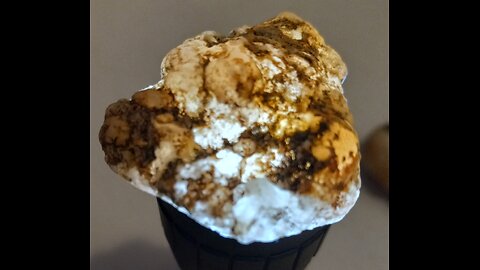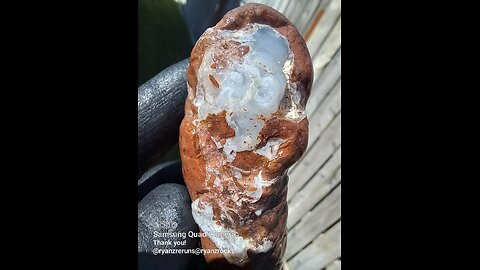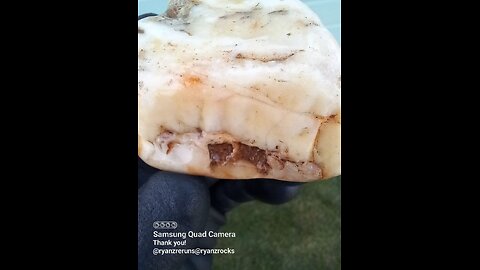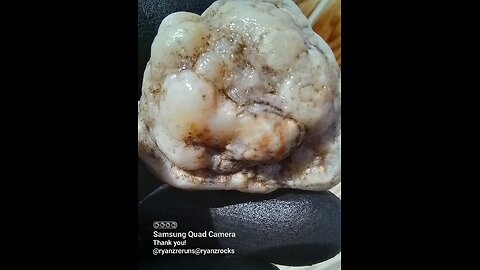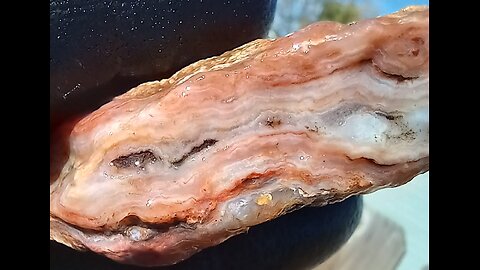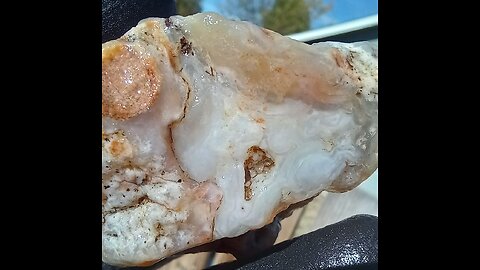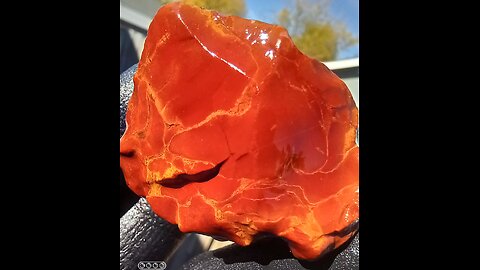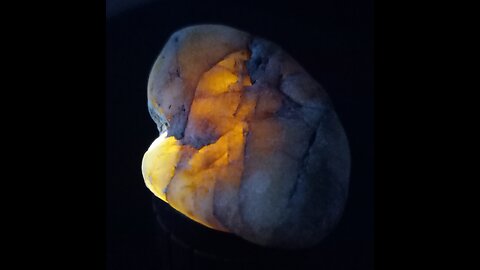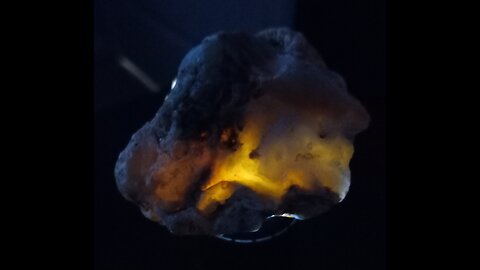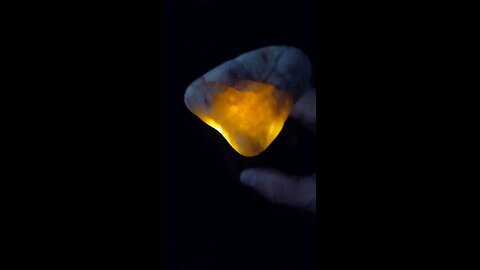Premium Only Content
This video is only available to Rumble Premium subscribers. Subscribe to
enjoy exclusive content and ad-free viewing.
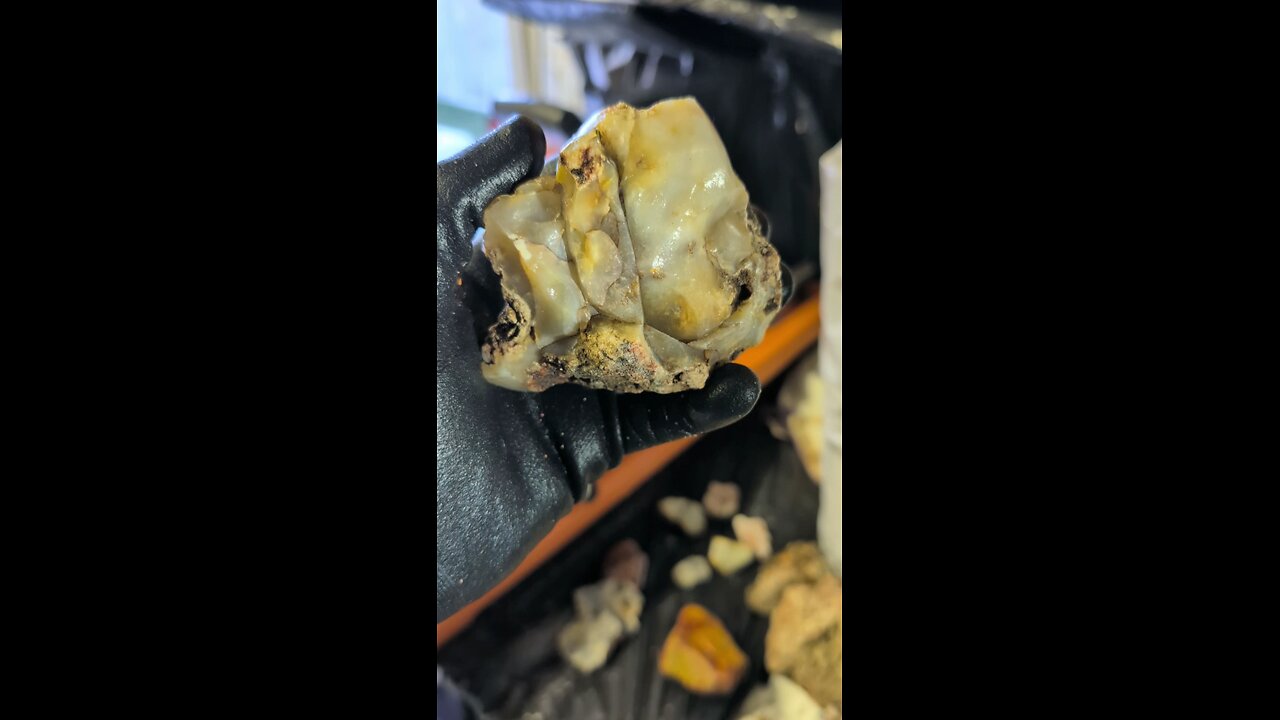
Chalcedony!
HumbleConservative
- 21 / 100
1
Slab o' Plume!
HumbleConservative
Plume agate is a distinctive variety of agate, known for its unique and intricate patterns that resemble plumes, feathers, or even landscapes. Here are some key points about plume agate:
Formation: Plume agate forms when silica-rich solutions seep into cavities in volcanic rocks. The "plumes" are created by manganese or iron oxides that get trapped in the silica, forming these feather-like patterns.
Colors: The colors of plume agate can vary widely depending on the minerals present. Common colors include reds, browns, yellows, blacks, and whites, with the plumes often contrasting against the base color of the agate.
Locations: Notable locations where plume agate is found include Oregon in the United States (specifically, the Owyhee Mountain area), Mexico, and Brazil. Each location can produce agates with unique characteristics.
Uses: Plume agate is popular among collectors and is often used in jewelry like pendants, rings, and beads due to its aesthetic appeal. It's also valued in metaphysical communities, where it's believed to enhance one's connection to the Earth, promote creativity, and aid in grounding.
Care: Like other agates, plume agate is relatively hard (about 6.5-7 on the Mohs scale), making it durable for jewelry. However, it should be protected from sharp blows or extreme temperature changes to avoid cracking.
Identification: When identifying plume agate, look for the characteristic plume-like inclusions. These inclusions should appear as if they are floating within the stone, giving a 3D effect when viewed from different angles.
Plume agate's beauty lies in its natural patterns, which can look like trees, clouds, or even abstract art, making each piece unique.
2
Whole & Broken Geodes!
HumbleConservative
A geode is a hollow, usually spherical rock, that when broken open reveals a cavity lined with crystals or other mineral formations. Here are some key points about geodes:
Formation: Geodes form when gas bubbles or cavities in volcanic or sedimentary rock are filled with mineral-rich water. As the water evaporates, it leaves behind minerals which crystallize over time, lining the inside of the cavity.
Structure: The outer layer of a geode is typically rough and nondescript, often making it look like an ordinary rock until it's cracked open. Inside, you might find crystals like quartz, amethyst, calcite, or even rarer minerals.
Location: They are commonly found in regions with volcanic activity or limestone deposits. Famous locations include parts of the United States, Brazil, Uruguay, and Mexico.
Uses: Geodes are popular among rock collectors and are often cut and polished for use in jewelry or as decorative pieces. Some are also used in metaphysical practices for their supposed healing properties.
Identification: To identify a geode, one would typically look for a rock that is unusually light for its size or has a hollow sound when tapped. However, the only definitive way to confirm is by breaking it open or using specialized equipment like X-rays.
If you're interested in finding or identifying geodes, or if you have any other questions about them, feel free to ask!Rabbit Springs Geode Field, is a well-known rockhounding site located in southern Idaho near the Nevada border. It’s a popular spot for collectors seeking thundereggs—spherical rocks that often contain beautiful agate or crystal-filled centers, some of which fluoresce under UV light due to mineral content like chalcedony or quartz.
3
Moss Agate Polish!
HumbleConservative
Moss agate is a type of chalcedony, a mineral in the quartz family, known for its unique and beautiful appearance. It’s typically translucent to semi-opaque with a milky or clear base, featuring green, moss-like inclusions that resemble tiny ferns, trees, or landscapes. These inclusions are usually formed by minerals like chlorite, iron, or manganese, giving it that earthy, forest-floor vibe.
Unlike true agates, which have banded patterns, moss agate doesn’t always show banding—its charm lies in those organic, dendritic (branch-like) designs. It’s often used in jewelry, like rings or pendants, because of its durability (it’s about a 6.5-7 on the Mohs hardness scale) and its one-of-a-kind look. People also associate it with calming, grounding energy in crystal enthusiast circles, though that’s more anecdotal than scientific.
Found in places like India, Brazil, and the U.S., it’s been prized for centuries, even popping up in ancient cultures for decorative or spiritual uses. Each piece is a little different, which is part of what makes it so cool.
1
comment
4
Geode Field!
HumbleConservative
Rabbit Springs Geode Field, also known as Rabbit Springs Thundereggs, is a well-known rockhounding site located in southern Idaho near the Nevada border. It’s a popular spot for collectors seeking thundereggs—spherical rocks that often contain beautiful agate or crystal-filled centers, some of which fluoresce under UV light due to mineral content like chalcedony or quartz. This site sits along U.S. Highway 93, roughly 38 miles from Twin Falls, Idaho, and about 130 miles from Mountain Home, making it accessible yet remote enough to feel like a true adventure.
The coordinates for Rabbit Springs are approximately 42.06572°N, -114.67387°W. You can get there by driving south from Twin Falls toward Jackpot, Nevada, and looking for the old Rabbit Springs rest area, a historical marker for the site. The terrain is rugged, typical of the high desert landscape in this region, with volcanic and sedimentary rocks from ancient geological activity providing the perfect conditions for thunderegg formation. These rocks are remnants of gas pockets in lava flows that filled with silica-rich fluids over millions of years.
No heavy digging is necessary here—surface collecting with a bucket is the way to go, as many thundereggs are weathered out and scattered across the ground. A rock hammer might come in handy to crack them open, but locals and seasoned rockhounds suggest the best finds are often already exposed, and breaking into the bedrock isn’t worth the effort. The thundereggs vary in size, from plums to grapefruits, and some glow a striking green or orange under a 365nm UV light, thanks to trace minerals. Rumors of radioactivity have floated around, but tests with Geiger counters have debunked that myth.
The site is on public land managed by the Bureau of Land Management (BLM), so casual collecting is allowed as long as you’re not using heavy machinery or digging extensive tunnels—stick to hand tools and surface finds. Any vehicle can make the trip, though the final approach might involve a short walk from the highway. September’s cooler weather makes it an ideal time to visit, avoiding the summer heat of this arid region.
5
Agate Drop!
HumbleConservative
Agate is a microcrystalline variety of quartz, specifically a form of chalcedony, known for its fine grain and bright color patterns. Here are some key points about agate:
Formation: Agate forms in volcanic and sedimentary rocks. It often begins as a cavity in the rock, which then gets filled with layers of silica-rich water. Over time, this solution deposits minerals in layers, creating the characteristic banding of agate. This process can take millions of years.
Appearance: Agate is famous for its beautiful, often banded patterns of color, which can range from translucent to opaque. Colors include white, blue, red, black, yellow, and brown among others, with the patterns formed by the successive layers of chalcedony being deposited. Sometimes, agates can be found with inclusions like moss (moss agate) or even fossils.
Types of Agate:
Banded Agate: Shows clear, concentric bands of color.
Moss Agate: Contains mineral inclusions that look like moss or foliage.
Dendritic Agate: Similar to moss agate but with tree-like or branch-like patterns.
Fire Agate: Contains iridescent layers that appear to glow with fiery colors.
Lace Agate: Features lace-like patterns, most notably in Blue Lace Agate from Namibia.
Crazy Lace Agate: Known for its wild, chaotic patterns of colors.
Locations: Agates are found worldwide, but some of the most famous locations include Brazil, Uruguay, Mexico, Germany, Madagascar, and the United States (particularly in Oregon, Washington, and Idaho).
Uses:
Jewelry: Due to its beauty when polished, agate is widely used in jewelry like rings, pendants, and beads.
Decorative Items: Larger pieces or slices are used for decorative objects, bookends, or as display pieces.
Metaphysical: In metaphysical practices, agate is believed to have various healing properties, like balancing physical, emotional, and intellectual energy, and promoting strength and courage.
Cultural Significance: Agate has been used since ancient times; it was prized in Ancient Egypt for amulets and seals, in Greece and Rome for intaglios and cameos, and by many other cultures for its beauty and supposed protective qualities.
Cutting and Polishing: When cutting agate for jewelry or display, lapidaries look for the most visually appealing patterns. The process involves sawing, grinding, and polishing to bring out the internal beauty of the stone.
Agate's diversity in color and pattern, combined with its durability, makes it one of the most sought-after stones in the world of gemology and mineral collecting.
6
Botryoidal cut!
HumbleConservative
Botryoidal is a term used in mineralogy to describe a mineral or rock formation that has a rounded, grape-like, or botryoidal (from the Greek word "botryoeidēs" meaning "like a bunch of grapes") shape. Here are some key points about botryoidal formations:
Formation: Botryoidal structures form when minerals precipitate from solution in a way that creates rounded, nodular surfaces. This often happens in cavities or vugs within rocks where mineral-rich solutions slowly deposit layers of minerals, building up in a manner that mimics the shape of grapes.
Common Minerals: Some minerals commonly found in botryoidal forms include:
Hematite: Often forms botryoidal shapes with a metallic luster.
Malachite: Known for its vibrant green botryoidal formations.
Goethite: Can exhibit botryoidal textures, usually in brown or yellow hues.
Chalcedony: Including varieties like agate, which can form botryoidal layers within geodes.
Psilomelane: A manganese oxide mineral often found in botryoidal shapes.
Texture: The texture of botryoidal minerals is smooth and rounded, with a surface that looks like clusters of small spheres or nodules. This texture is due to the slow, even deposition of mineral material from solution.
Uses:
Jewelry and Decoration: Botryoidal minerals are prized for their unique shapes and are often polished or cut into cabochons for use in jewelry. They can also be used as decorative stones.
Collectors: Due to their distinctive appearance, botryoidal specimens are popular among mineral collectors.
Art: Their natural beauty makes them suitable for artistic endeavors, including sculptures or inlays.
Geological Significance: Botryoidal formations can provide insights into the conditions under which the minerals precipitated, often indicating slow, stable conditions conducive to this type of growth. They are also indicators of the fluid dynamics and chemistry in the environment where they formed.
7
Shaping!
HumbleConservative
A Thunderegg is a geological structure similar to a geode but with unique characteristics. Here's an overview:
Formation: Thundereggs form within rhyolitic volcanic ash layers. They start as gas bubbles or steam pockets in the lava, which act as molds. Over time, these are filled with silica-rich fluids, mainly chalcedony, agate, jasper, or opal, creating intricate patterns and colors inside.
Appearance: On the outside, thundereggs look like ordinary, rough-textured rocks, often with a white-gray to reddish-brown surface. However, when cut and polished, they reveal a variety of internal structures, from solid agate or chalcedony cores to sometimes hollow centers with crystals.
Size: They can range from small, about the size of a baseball, to larger specimens over a meter across, though most commonly they are between two to six inches in diameter.
Locations: While Oregon, USA, is particularly famous for thundereggs, especially in counties like Crook, Jefferson, Malheur, Wasco, and Wheeler, they are found globally wherever the geological conditions are right. Other notable locations include Germany, Australia, Brazil, Canada, Mexico, Poland, Romania, and Turkey.
Cultural Significance: In Oregon, the thunderegg was designated as the state rock in 1965, reflecting its importance in local geology and culture. Native American legends attribute their formation to thunder spirits or gods throwing these rocks during thunderstorms.
Collection and Use: Thundereggs are popular among rock collectors for their unique beauty once cut open. They're often used in jewelry making or as display pieces due to their aesthetic appeal after being sliced and polished.
Variations: Each thunderegg is unique due to the minerals present in the area where it forms, leading to a wide variety in color, pattern, and structure even from the same bed.
8
Chalcedony glow!
HumbleConservative
This rock appears to be a type of agate, specifically a form known as Banded Agate or Fortification Agate. Here are some key characteristics that led to this identification:
Banded Structure: The rock shows clear banding, which is characteristic of agates formed in cavities where silica-rich solutions deposit in layers over time.
Translucency: Parts of the rock are translucent, which is typical for agate due to its chalcedony composition.
Color Variations: The presence of various shades like white, brown, and hints of yellow or orange indicates different mineral inclusions or variations in the silica deposition process.
Patterns: The patterns resemble a fortification or landscape, which is common in fortification agates where the bands follow the outline of the cavity in which they formed.
Agates are a variety of chalcedony, which is a cryptocrystalline form of silica, and they often contain colorful bands or layers due to changes in the composition of the depositing fluids or the presence of different minerals. This particular specimen seems to have been polished or naturally smoothed, enhancing its translucency and the visibility of its internal structures.
If you're interested in further identification or more detailed information, I could suggest searching for similar examples or consulting with a mineralogist or gemologist.
9
Botryoidal Chalcedony n' Jasper Glow!
HumbleConservative
Brecciated Jasper with chalcedony is a fascinating combination in the world of gemstones and minerals, offering both visual complexity and a unique geological story. Here's an overview:
Brecciated Jasper:
Formation: Brecciated Jasper forms when fragments of jasper (which is a form of microcrystalline quartz) are cemented together by a later mineral deposit. This process often involves the fracturing of existing jasper through geological activities like faulting or weathering, followed by the filling of these fractures with siliceous material, often chalcedony or quartz.
Appearance: The result is a rock with a mosaic-like appearance, where different colored jasper fragments are held together by the matrix. The colors can vary widely, but reds, browns, yellows, and greens are common, with the matrix often being a lighter or contrasting color.
Properties: Brecciated Jasper is known for its grounding and protective qualities in metaphysical circles. It's believed to stabilize energy and bring about feelings of wholeness and strength.
Chalcedony:
Nature: Chalcedony is a cryptocrystalline form of silica, consisting of very fine intergrowths of quartz and moganite. It can appear in a range of colors, from translucent white to various hues, depending on impurities.
In Brecciated Jasper: When chalcedony acts as the cement in Brecciated Jasper, it contributes to the stone's overall appearance by providing a contrasting matrix. This chalcedony can be translucent to semi-translucent, adding a different texture and sometimes color to the piece.
Visual Effect: The combination creates a striking visual contrast, where the angular or jagged pieces of jasper are highlighted against the smoother, often lighter chalcedony matrix. This can result in patterns that look like broken glass or stained glass windows.
Combined Properties:
Aesthetic: This combination is particularly sought after for its unique, mosaic-like beauty. It's used in jewelry, decorative items, and lapidary arts where the natural patterning can be showcased.
Geological Interest: From a geological perspective, this stone tells a story of disruption and healing in the Earth's crust, where old rock is broken and then naturally mended with new material.
Healing and Metaphysical Uses: The addition of chalcedony might enhance the stone's reputed healing properties, like promoting emotional balance, nurturing, and communication, complementing the stabilizing effects of jasper.
Availability and Use: You can find this type of jasper in various forms, from polished cabochons for jewelry to raw or tumbled stones for collectors or metaphysical use. It's sourced from places like Brazil, India, and the United States, among other locations.
When buying or working with Brecciated Jasper with chalcedony, look for pieces where the contrast between the jasper fragments and the chalcedony matrix is most pronounced for maximum visual impact. Remember, like all natural stones, each piece can be quite unique due to the natural processes involved in its formation.
10
Broken Thunderegg Cluster!
HumbleConservative
A Thunderegg is a geological structure similar to a geode but with unique characteristics. Here's an overview:
Formation: Thundereggs form within rhyolitic volcanic ash layers. They start as gas bubbles or steam pockets in the lava, which act as molds. Over time, these are filled with silica-rich fluids, mainly chalcedony, agate, jasper, or opal, creating intricate patterns and colors inside.
Appearance: On the outside, thundereggs look like ordinary, rough-textured rocks, often with a white-gray to reddish-brown surface. However, when cut and polished, they reveal a variety of internal structures, from solid agate or chalcedony cores to sometimes hollow centers with crystals.
Size: They can range from small, about the size of a baseball, to larger specimens over a meter across, though most commonly they are between two to six inches in diameter.
Locations: While Oregon, USA, is particularly famous for thundereggs, especially in counties like Crook, Jefferson, Malheur, Wasco, and Wheeler, they are found globally wherever the geological conditions are right. Other notable locations include Germany, Australia, Brazil, Canada, Mexico, Poland, Romania, and Turkey.
Cultural Significance: In Oregon, the thunderegg was designated as the state rock in 1965, reflecting its importance in local geology and culture. Native American legends attribute their formation to thunder spirits or gods throwing these rocks during thunderstorms.
Collection and Use: Thundereggs are popular among rock collectors for their unique beauty once cut open. They're often used in jewelry making or as display pieces due to their aesthetic appeal after being sliced and polished.
Variations: Each thunderegg is unique due to the minerals present in the area where it forms, leading to a wide variety in color, pattern, and structure even from the same bed.
11
Chalcedony n' Quartz Veins!
HumbleConservative
Chalcedony is a cryptocrystalline form of silica, which means it's composed of very fine intergrowths of quartz and moganite. These crystals are so small that they can only be seen under high magnification. Chalcedony has a waxy luster and can appear in a variety of colors, often due to impurities or inclusions within the stone. Here are some key points about chalcedony:
Composition: It's primarily made of silica (SiO₂), with quartz and moganite being the two main components.
Varieties: Chalcedony includes several well-known gemstones like agate, onyx, jasper, carnelian, and chrysoprase, each with distinct patterns or colors.
Formation: It typically forms in the cavities of volcanic rocks, where silica-rich solutions deposit over time.
Properties: It has a hardness of 6.5 to 7 on the Mohs scale, making it quite durable. Its toughness and ability to take a high polish make it popular in jewelry and decorative items.
Uses: Besides being used in jewelry, chalcedony has historical significance in tool-making, art, and even as a gemstone for metaphysical purposes.
12
Half a thunderegg!
HumbleConservative
A Thunderegg is a geological structure similar to a geode but with unique characteristics. Here's an overview:
Formation: Thundereggs form within rhyolitic volcanic ash layers. They start as gas bubbles or steam pockets in the lava, which act as molds. Over time, these are filled with silica-rich fluids, mainly chalcedony, agate, jasper, or opal, creating intricate patterns and colors inside.
Appearance: On the outside, thundereggs look like ordinary, rough-textured rocks, often with a white-gray to reddish-brown surface. However, when cut and polished, they reveal a variety of internal structures, from solid agate or chalcedony cores to sometimes hollow centers with crystals.
Size: They can range from small, about the size of a baseball, to larger specimens over a meter across, though most commonly they are between two to six inches in diameter.
Locations: While Oregon, USA, is particularly famous for thundereggs, especially in counties like Crook, Jefferson, Malheur, Wasco, and Wheeler, they are found globally wherever the geological conditions are right. Other notable locations include Germany, Australia, Brazil, Canada, Mexico, Poland, Romania, and Turkey.
Cultural Significance: In Oregon, the thunderegg was designated as the state rock in 1965, reflecting its importance in local geology and culture. Native American legends attribute their formation to thunder spirits or gods throwing these rocks during thunderstorms.
Collection and Use: Thundereggs are popular among rock collectors for their unique beauty once cut open. They're often used in jewelry making or as display pieces due to their aesthetic appeal after being sliced and polished.
Variations: Each thunderegg is unique due to the minerals present in the area where it forms, leading to a wide variety in color, pattern, and structure even from the same bed.
13
Thunderegg Cluster w Common Opal!
HumbleConservative
A Thunderegg is a geological structure similar to a geode but with unique characteristics. Here's an overview:
Formation: Thundereggs form within rhyolitic volcanic ash layers. They start as gas bubbles or steam pockets in the lava, which act as molds. Over time, these are filled with silica-rich fluids, mainly chalcedony, agate, jasper, or opal, creating intricate patterns and colors inside.
Appearance: On the outside, thundereggs look like ordinary, rough-textured rocks, often with a white-gray to reddish-brown surface. However, when cut and polished, they reveal a variety of internal structures, from solid agate or chalcedony cores to sometimes hollow centers with crystals.
Size: They can range from small, about the size of a baseball, to larger specimens over a meter across, though most commonly they are between two to six inches in diameter.
Locations: While Oregon, USA, is particularly famous for thundereggs, especially in counties like Crook, Jefferson, Malheur, Wasco, and Wheeler, they are found globally wherever the geological conditions are right. Other notable locations include Germany, Australia, Brazil, Canada, Mexico, Poland, Romania, and Turkey.
Cultural Significance: In Oregon, the thunderegg was designated as the state rock in 1965, reflecting its importance in local geology and culture. Native American legends attribute their formation to thunder spirits or gods throwing these rocks during thunderstorms.
Collection and Use: Thundereggs are popular among rock collectors for their unique beauty once cut open. They're often used in jewelry making or as display pieces due to their aesthetic appeal after being sliced and polished.
Variations: Each thunderegg is unique due to the minerals present in the area where it forms, leading to a wide variety in color, pattern, and structure even from the same bed.
14
Red Thunderegg Shard!
HumbleConservative
A Thunderegg is a geological structure similar to a geode but with unique characteristics. Here's an overview:
Formation: Thundereggs form within rhyolitic volcanic ash layers. They start as gas bubbles or steam pockets in the lava, which act as molds. Over time, these are filled with silica-rich fluids, mainly chalcedony, agate, jasper, or opal, creating intricate patterns and colors inside.
Appearance: On the outside, thundereggs look like ordinary, rough-textured rocks, often with a white-gray to reddish-brown surface. However, when cut and polished, they reveal a variety of internal structures, from solid agate or chalcedony cores to sometimes hollow centers with crystals.
Size: They can range from small, about the size of a baseball, to larger specimens over a meter across, though most commonly they are between two to six inches in diameter.
Locations: While Oregon, USA, is particularly famous for thundereggs, especially in counties like Crook, Jefferson, Malheur, Wasco, and Wheeler, they are found globally wherever the geological conditions are right. Other notable locations include Germany, Australia, Brazil, Canada, Mexico, Poland, Romania, and Turkey.
Cultural Significance: In Oregon, the thunderegg was designated as the state rock in 1965, reflecting its importance in local geology and culture. Native American legends attribute their formation to thunder spirits or gods throwing these rocks during thunderstorms.
Collection and Use: Thundereggs are popular among rock collectors for their unique beauty once cut open. They're often used in jewelry making or as display pieces due to their aesthetic appeal after being sliced and polished.
Variations: Each thunderegg is unique due to the minerals present in the area where it forms, leading to a wide variety in color, pattern, and structure even from the same bed.
15
Botryoidal Geode!
HumbleConservative
This rock appears to be a geode filled with chalcedony or agate. Here's a detailed explanation:
Geode: Geodes are hollow, vaguely spherical rocks, often formed in volcanic and sedimentary rocks. They have a thin outer layer and are typically lined with crystals inside. The one in the image has been cut open to reveal its interior.
Chalcedony: This is a cryptocrystalline form of silica, composed of very fine intergrowths of quartz and moganite. Chalcedony can appear in various colors and forms, including agate, which has banding or layers.
Agate: If the chalcedony within the geode shows banding or layers, it could be classified as agate. Agate typically has more distinct color bands, which might not be very clear in this specimen due to the type of formation or the cut.
Formation: Geodes form when gas bubbles or volcanic cavities get filled with mineral-rich water. Over time, the minerals precipitate out of the water, forming layers or crystals inside the cavity. In this case, the minerals appear to have formed botryoidal (grape-like) structures, which is common in chalcedony.
Appearance: The white to light gray, rounded, botryoidal formations inside the geode suggest chalcedony. The outer shell seems to be a mix of quartz and possibly some iron staining, giving it the brownish hues.
16
Botryoidal Geode!
HumbleConservative
A geode is a hollow, usually spherical rock, that when broken open reveals a cavity lined with crystals or other mineral formations. Here are some key points about geodes:
Formation: Geodes form when gas bubbles or cavities in volcanic or sedimentary rock are filled with mineral-rich water. As the water evaporates, it leaves behind minerals which crystallize over time, lining the inside of the cavity.
Structure: The outer layer of a geode is typically rough and nondescript, often making it look like an ordinary rock until it's cracked open. Inside, you might find crystals like quartz, amethyst, calcite, or even rarer minerals.
Location: They are commonly found in regions with volcanic activity or limestone deposits. Famous locations include parts of the United States, Brazil, Uruguay, and Mexico.
Uses: Geodes are popular among rock collectors and are often cut and polished for use in jewelry or as decorative pieces. Some are also used in metaphysical practices for their supposed healing properties.
17
Botryoidal Plume Agate!
HumbleConservative
A botryoidal formation refers to a mineral structure that resembles a cluster of grapes or small, rounded, and knobby protrusions. Here are some details about botryoidal formations:
Characteristics:
Shape: The term "botryoidal" comes from the Greek word "botryoeides," meaning "grape-like." These formations have a surface that looks like a bunch of grapes.
Texture: They typically have a smooth, rounded surface, which can sometimes be polished to enhance their appearance.
Formation:
Process: Botryoidal formations occur when minerals precipitate from solution in a manner that favors the growth of rounded, nodular shapes. This often happens in cavities or vugs where mineral-rich fluids slowly deposit layers over time.
Common Minerals: Minerals that commonly form botryoidal structures include:
Hematite: Often found in botryoidal forms, giving a shiny, metallic luster.
Malachite: Known for its vibrant green color in botryoidal formations.
Goethite: Can exhibit botryoidal textures, often with a brownish to yellowi
18
Chalcedony Geode!
HumbleConservative
A geode is a hollow, usually spherical rock, that when broken open reveals a cavity lined with crystals or other mineral formations. Here are some key points about geodes:
Formation: Geodes form when gas bubbles or cavities in volcanic or sedimentary rock are filled with mineral-rich water. As the water evaporates, it leaves behind minerals which crystallize over time, lining the inside of the cavity.
Structure: The outer layer of a geode is typically rough and nondescript, often making it look like an ordinary rock until it's cracked open. Inside, you might find crystals like quartz, amethyst, calcite, or even rarer minerals.
Location: They are commonly found in regions with volcanic activity or limestone deposits. Famous locations include parts of the United States, Brazil, Uruguay, and Mexico.
Uses: Geodes are popular among rock collectors and are often cut and polished for use in jewelry or as decorative pieces. Some are also used in metaphysical practices for their supposed healing properties.
Identific
19
Geode Shot Glass!
HumbleConservative
A geode is a hollow, usually spherical rock, that when broken open reveals a cavity lined with crystals or other mineral formations. Here are some key points about geodes:
Formation: Geodes form when gas bubbles or cavities in volcanic or sedimentary rock are filled with mineral-rich water. As the water evaporates, it leaves behind minerals which crystallize over time, lining the inside of the cavity.
Structure: The outer layer of a geode is typically rough and nondescript, often making it look like an ordinary rock until it's cracked open. Inside, you might find crystals like quartz, amethyst, calcite, or even rarer minerals.
Location: They are commonly found in regions with volcanic activity or limestone deposits. Famous locations include parts of the United States, Brazil, Uruguay, and Mexico.
Uses: Geodes are popular among rock collectors and are often cut and polished for use in jewelry or as decorative pieces. Some are also used in metaphysical practices for their supposed healing properties.
Identification: To identify a geode, one would typically look for a rock that is unusually light for its size or has a hollow sound when tapped. However, the only definitive way to confirm is by breaking it open or using specialized equipment like X-rays.
20
Chalcedony Geode w/opal!
HumbleConservative
A geode is a hollow, usually spherical rock, that when broken open reveals a cavity lined with crystals or other mineral formations. Here are some key points about geodes:
Formation: Geodes form when gas bubbles or cavities in volcanic or sedimentary rock are filled with mineral-rich water. As the water evaporates, it leaves behind minerals which crystallize over time, lining the inside of the cavity.
Structure: The outer layer of a geode is typically rough and nondescript, often making it look like an ordinary rock until it's cracked open. Inside, you might find crystals like quartz, amethyst, calcite, or even rarer minerals.
Location: They are commonly found in regions with volcanic activity or limestone deposits. Famous locations include parts of the United States, Brazil, Uruguay, and Mexico.
Uses: Geodes are popular among rock collectors and are often cut and polished for use in jewelry or as decorative pieces. Some are also used in metaphysical practices for their supposed healing properties.
Identification: To identify a geode, one would typically look for a rock that is unusually light for its size or has a hollow sound when tapped. However, the only definitive way to confirm is by breaking it open or using specialized equipment like X-rays.
Agate Cut!
HumbleConservative
Based on the appearance of the rock in the image, it looks like it could be a type of chalcedony, specifically an agate. Agates are known for their banded or layered appearance, often with translucent to semi-translucent qualities. The rock in the image shows a mix of colors and a somewhat banded structure, which is characteristic of agates. They commonly form in volcanic and sedimentary rocks and are often found in cavities or veins.
22
Hot mess of Conglomerate!
HumbleConservative
Conglomerate is a type of sedimentary rock characterized by its composition of rounded to subangular gravel-size clasts or larger particles that are cemented together by a finer-grained matrix. Here are some key points about conglomerate:
Composition: Conglomerates are made up of various rock fragments, pebbles, and sometimes even larger stones, all of which are embedded in a matrix of sand, silt, or clay. The clasts can be of different rock types, including quartz, granite, basalt, or limestone.
Formation: They form in environments where there is strong water current or wave action, such as riverbeds, beaches, or alluvial fans, which can transport and deposit these larger particles. Over time, these deposits are compacted and cemented by minerals like silica, calcium carbonate, or iron oxide.
Texture: The texture of conglomerate is quite distinctive due to the presence of larger, rounded clasts within a finer matrix. This gives it a "cobblestone" or "pudding stone" appearance.
Color: The color of conglomerate can vary widely depending on the composition of the clasts and the cementing material. It can range from light to dark colors, often reflecting the colors of the included fragments.
Uses: Conglomerate is sometimes used as a building stone due to its durability, though it's less common than other rocks like sandstone or limestone. It's also of interest in geology for understanding ancient environments and sediment transport processes.
23
Jasper w/iron inclusions!
HumbleConservative
Jasper is a type of chalcedony, which is a microcrystalline variety of quartz. Specifically, jasper is known for its opaque appearance and often comes in various colors, primarily red, yellow, brown, or green, due to the presence of impurities like iron oxides or other minerals. Here are some key characteristics of jasper:
Texture: Typically fine-grained with a smooth, sometimes waxy, surface.
Hardness: On the Mohs scale, jasper ranks between 6.5 and 7, making it quite durable.
Formation: Jasper forms in hydrothermal veins, volcanic rocks, or as sedimentary deposits. It can also occur in nodules or as a cementing material in conglomerates.
Jasper often exhibits patterns or banding, which can be quite striking, leading to its use in jewelry, decorative items, and even in ancient artifacts for its beauty and durability. Varieties of jasper include:
Picture Jasper: Known for its landscape-like patterns.
Red Jasper: Often uniform in color, used for its deep red hue.
Ocean Jasper: Characterized by orbicular pat
24
Chalcedony Chunk!
HumbleConservative
This rock looks like it could be a type of chalcedony, specifically a variety known as carnelian or possibly agate. Carnelian is known for its rich, warm colors ranging from orange to reddish-brown, which seems to match the coloration of the rock shown. Agate, on the other hand, often has banding or layers, which might be present here but is less distinct. Both are forms of silica and are commonly polished for decorative purposes due to their attractive appearance.
25
Plume agate!
HumbleConservative
This rock looks like a type of chalcedony, specifically a variety known as "plume agate." Plume agate is characterized by its translucent to semi-translucent body with inclusions that resemble plumes or feathers, often in shades of red, brown, or black, which matches the reddish inclusions you see in the rock.
26
Can't wait to cut this one!
HumbleConservative
This rock looks like it could be a type of agate or chalcedony. These rocks are known for their banded or layered appearance, often with translucent to semi-translucent qualities. The white, translucent areas and the reddish-brown matrix suggest it might be a type of agate with iron oxide inclusions.
27
Crazy Lace Agate Cut!
HumbleConservative
Crazy Lace Agate, also known as Mexican Agate, is a Chalcedony variety with inclusions of Iron and Aluminum. This crystal’s physical pattern is completely unique and has large swirls, banding, and orbicular formations much resembling Ocean Jasper. The colors of the stone range from a cream to beige with red, black, brown, grey, and white patterns. Its crystal formation is perfect for cutting and carving. You will commonly find this stone in the shape of squares, circles, skulls, points, and tumbled. Crazy Lace Agate is believed to have been formed between 65-90 million years ago in Earth's Cretaceous period.
28
Thundereggs?
HumbleConservative
These rocks appears to be a type of **thunder egg**. Here's why:
1. **Coloration and Banding**: The rock shows a combination of colors, including brown, white, green, and possibly some hints of other colors, which is typical for agates and thunder eggs. The banding pattern is also characteristic of agates, which form in cavities of volcanic rocks.
2. **Translucency**: Some parts of the rock are translucent, which is common in agates due to their chalcedony composition.
3. **Texture**: The rock's texture looks somewhat waxy or glassy, which is typical for agates that have been polished or naturally worn smooth.
4. **Inclusions**: The yellowish or brownish areas could be due to iron oxide or other mineral inclusions, which are often found in agates. Thunder eggs are nodules of agate found in volcanic rocks, and they often have a hollow or partially hollow interior filled with crystals or banded agate.
29
Chalcedony & Crazy Lace Cut!
HumbleConservative
Crazy Lace Agate, also known as Mexican Agate, is a Chalcedony variety with inclusions of Iron and Aluminum. This crystal’s physical pattern is completely unique and has large swirls, banding, and orbicular formations much resembling Ocean Jasper. The colors of the stone range from a cream to beige with red, black, brown, grey, and white patterns. Its crystal formation is perfect for cutting and carving. You will commonly find this stone in the shape of squares, circles, skulls, points, and tumbled. Crazy Lace Agate is believed to have been formed between 65-90 million years ago in Earth's Cretaceous period.
30
Plume w/CrazyLace cut!
HumbleConservative
Plume Agate is a captivating variety of agate, renowned for its intricate and delicate feather-like inclusions. These mesmerizing formations resemble ethereal plumes or wisps suspended within the stone, creating a stunning visual effect. It belongs to the chalcedony family, characterized by its microcrystalline structure and vibrant colors.
Plume Agate derives its name from the feathery patterns that adorn its surface. These patterns are typically composed of mineral deposits, often in striking hues such as white, cream, pink, or red, contrasting against a translucent or opaque background. These intricate formations are formed through the slow crystallization of silica-rich solutions within cavities or fissures in volcanic rocks.
Each piece of Plume Agate is unique, showcasing a kaleidoscope of colors and patterns. The delicate plumes within the stone evoke a sense of tranquility and beauty, making it a highly sought-after gemstone among collectors and jewelry enthusiasts alike.
Plume Agate holds significant importance in the world of gemstones and jewelry for several reasons:
Aesthetic Appeal: Plume Agate’s captivating patterns and vibrant colors make it a favorite among jewelry designers and collectors. Its unique beauty adds an element of elegance and individuality to any piece of jewelry.
Metaphysical Properties: In addition to its visual allure, Plume Agate is believed to possess metaphysical properties that promote harmony, balance, and emotional healing. It is often used in alternative healing practices and spiritual rituals.
Collectibility: Due to its rarity and unique characteristics, Plume Agate is highly prized by gemstone collectors. Specimens with exceptional plume formations or intense colors can command high prices in the market.
Versatility: Plume Agate’s diverse color palette and patterns make it a versatile gemstone for jewelry design. It can be fashioned into various shapes and sizes, including cabochons, beads, and carvings, allowing for creativity and innovation in jewelry making.
Historical Significance: Throughout history, agates have been revered for their beauty and perceived mystical properties. Plume Agate, with its distinct plume-like inclusions, has been admired and utilized in adornments and talismans by ancient civilizations.
Plume Agate stands out as a gemstone of exceptional beauty, imbued with both aesthetic and metaphysical significance. Its popularity in the world of gemstones and jewelry continues to endure, captivating admirers with its mesmerizing patterns and timeless allure.
- https://geologyscience.com/gemstone/plume-agate/
31
Thought it would be three thundereggs!?!?
HumbleConservative
Based on the visual characteristics of the rock in the image, it appears to be an iron-rich sedimentary rock, possibly an ironstone or banded iron formation (BIF). Here are some key observations:
Color: The rock has a reddish-brown hue, which is typical of iron oxides like hematite (Fe₂O₃) or goethite (FeO(OH)).
Texture: The rock shows a layered or banded structure with a mix of different shades of red, brown, and some lighter minerals, which suggests it might be a sedimentary rock formed in layers over time.
Luster: The wet appearance gives it a glossy look, which can sometimes help in identifying minerals by enhancing their color and luster.
Composition: The presence of small white or light-colored inclusions could be quartz, calcite, or other minerals commonly found in iron-rich sedimentary environments.
Ironstones are often formed in ancient marine or lake environments where iron was precipitated out of the water and deposited in layers. Banded iron formations are particularly notable for their distinct layers of iron oxides and silica, formed under specific chemical conditions in the Earth's early history.
32
Plume botryoidal chalcedony nugget!
HumbleConservative
Plume Agate is a captivating variety of agate, renowned for its intricate and delicate feather-like inclusions. These mesmerizing formations resemble ethereal plumes or wisps suspended within the stone, creating a stunning visual effect. It belongs to the chalcedony family, characterized by its microcrystalline structure and vibrant colors.
Plume Agate derives its name from the feathery patterns that adorn its surface. These patterns are typically composed of mineral deposits, often in striking hues such as white, cream, pink, or red, contrasting against a translucent or opaque background. These intricate formations are formed through the slow crystallization of silica-rich solutions within cavities or fissures in volcanic rocks.
Each piece of Plume Agate is unique, showcasing a kaleidoscope of colors and patterns. The delicate plumes within the stone evoke a sense of tranquility and beauty, making it a highly sought-after gemstone among collectors and jewelry enthusiasts alike.
Plume Agate holds significant importance in the world of gemstones and jewelry for several reasons:
Aesthetic Appeal: Plume Agate’s captivating patterns and vibrant colors make it a favorite among jewelry designers and collectors. Its unique beauty adds an element of elegance and individuality to any piece of jewelry.
Metaphysical Properties: In addition to its visual allure, Plume Agate is believed to possess metaphysical properties that promote harmony, balance, and emotional healing. It is often used in alternative healing practices and spiritual rituals.
Collectibility: Due to its rarity and unique characteristics, Plume Agate is highly prized by gemstone collectors. Specimens with exceptional plume formations or intense colors can command high prices in the market.
Versatility: Plume Agate’s diverse color palette and patterns make it a versatile gemstone for jewelry design. It can be fashioned into various shapes and sizes, including cabochons, beads, and carvings, allowing for creativity and innovation in jewelry making.
Historical Significance: Throughout history, agates have been revered for their beauty and perceived mystical properties. Plume Agate, with its distinct plume-like inclusions, has been admired and utilized in adornments and talismans by ancient civilizations.
Plume Agate stands out as a gemstone of exceptional beauty, imbued with both aesthetic and metaphysical significance. Its popularity in the world of gemstones and jewelry continues to endure, captivating admirers with its mesmerizing patterns and timeless allure.
- https://geologyscience.com/gemstone/plume-agate/
33
Plume slice!
HumbleConservative
Plume Agate is a captivating variety of agate, renowned for its intricate and delicate feather-like inclusions. These mesmerizing formations resemble ethereal plumes or wisps suspended within the stone, creating a stunning visual effect. It belongs to the chalcedony family, characterized by its microcrystalline structure and vibrant colors.
Plume Agate derives its name from the feathery patterns that adorn its surface. These patterns are typically composed of mineral deposits, often in striking hues such as white, cream, pink, or red, contrasting against a translucent or opaque background. These intricate formations are formed through the slow crystallization of silica-rich solutions within cavities or fissures in volcanic rocks.
Each piece of Plume Agate is unique, showcasing a kaleidoscope of colors and patterns. The delicate plumes within the stone evoke a sense of tranquility and beauty, making it a highly sought-after gemstone among collectors and jewelry enthusiasts alike.
Plume Agate holds significant importance in the world of gemstones and jewelry for several reasons:
Aesthetic Appeal: Plume Agate’s captivating patterns and vibrant colors make it a favorite among jewelry designers and collectors. Its unique beauty adds an element of elegance and individuality to any piece of jewelry.
Metaphysical Properties: In addition to its visual allure, Plume Agate is believed to possess metaphysical properties that promote harmony, balance, and emotional healing. It is often used in alternative healing practices and spiritual rituals.
Collectibility: Due to its rarity and unique characteristics, Plume Agate is highly prized by gemstone collectors. Specimens with exceptional plume formations or intense colors can command high prices in the market.
Versatility: Plume Agate’s diverse color palette and patterns make it a versatile gemstone for jewelry design. It can be fashioned into various shapes and sizes, including cabochons, beads, and carvings, allowing for creativity and innovation in jewelry making.
Historical Significance: Throughout history, agates have been revered for their beauty and perceived mystical properties. Plume Agate, with its distinct plume-like inclusions, has been admired and utilized in adornments and talismans by ancient civilizations.
Plume Agate stands out as a gemstone of exceptional beauty, imbued with both aesthetic and metaphysical significance. Its popularity in the world of gemstones and jewelry continues to endure, captivating admirers with its mesmerizing patterns and timeless allure.
- https://geologyscience.com/gemstone/plume-agate/
34
Botryoidal slice!
HumbleConservative
Plume Agate is a captivating variety of agate, renowned for its intricate and delicate feather-like inclusions. These mesmerizing formations resemble ethereal plumes or wisps suspended within the stone, creating a stunning visual effect. It belongs to the chalcedony family, characterized by its microcrystalline structure and vibrant colors.
Plume Agate derives its name from the feathery patterns that adorn its surface. These patterns are typically composed of mineral deposits, often in striking hues such as white, cream, pink, or red, contrasting against a translucent or opaque background. These intricate formations are formed through the slow crystallization of silica-rich solutions within cavities or fissures in volcanic rocks.
Each piece of Plume Agate is unique, showcasing a kaleidoscope of colors and patterns. The delicate plumes within the stone evoke a sense of tranquility and beauty, making it a highly sought-after gemstone among collectors and jewelry enthusiasts alike.
Plume Agate holds significant importance in the world of gemstones and jewelry for several reasons:
Aesthetic Appeal: Plume Agate’s captivating patterns and vibrant colors make it a favorite among jewelry designers and collectors. Its unique beauty adds an element of elegance and individuality to any piece of jewelry.
Metaphysical Properties: In addition to its visual allure, Plume Agate is believed to possess metaphysical properties that promote harmony, balance, and emotional healing. It is often used in alternative healing practices and spiritual rituals.
Collectibility: Due to its rarity and unique characteristics, Plume Agate is highly prized by gemstone collectors. Specimens with exceptional plume formations or intense colors can command high prices in the market.
Versatility: Plume Agate’s diverse color palette and patterns make it a versatile gemstone for jewelry design. It can be fashioned into various shapes and sizes, including cabochons, beads, and carvings, allowing for creativity and innovation in jewelry making.
Historical Significance: Throughout history, agates have been revered for their beauty and perceived mystical properties. Plume Agate, with its distinct plume-like inclusions, has been admired and utilized in adornments and talismans by ancient civilizations.
Plume Agate stands out as a gemstone of exceptional beauty, imbued with both aesthetic and metaphysical significance. Its popularity in the world of gemstones and jewelry continues to endure, captivating admirers with its mesmerizing patterns and timeless allure.
- https://geologyscience.com/gemstone/plume-agate/
35
Plume agate inspection!
HumbleConservative
Plume Agate is a captivating variety of agate, renowned for its intricate and delicate feather-like inclusions. These mesmerizing formations resemble ethereal plumes or wisps suspended within the stone, creating a stunning visual effect. It belongs to the chalcedony family, characterized by its microcrystalline structure and vibrant colors.
Plume Agate derives its name from the feathery patterns that adorn its surface. These patterns are typically composed of mineral deposits, often in striking hues such as white, cream, pink, or red, contrasting against a translucent or opaque background. These intricate formations are formed through the slow crystallization of silica-rich solutions within cavities or fissures in volcanic rocks.
Each piece of Plume Agate is unique, showcasing a kaleidoscope of colors and patterns. The delicate plumes within the stone evoke a sense of tranquility and beauty, making it a highly sought-after gemstone among collectors and jewelry enthusiasts alike.
Plume Agate holds significant importance in the world of gemstones and jewelry for several reasons:
Aesthetic Appeal: Plume Agate’s captivating patterns and vibrant colors make it a favorite among jewelry designers and collectors. Its unique beauty adds an element of elegance and individuality to any piece of jewelry.
Metaphysical Properties: In addition to its visual allure, Plume Agate is believed to possess metaphysical properties that promote harmony, balance, and emotional healing. It is often used in alternative healing practices and spiritual rituals.
Collectibility: Due to its rarity and unique characteristics, Plume Agate is highly prized by gemstone collectors. Specimens with exceptional plume formations or intense colors can command high prices in the market.
Versatility: Plume Agate’s diverse color palette and patterns make it a versatile gemstone for jewelry design. It can be fashioned into various shapes and sizes, including cabochons, beads, and carvings, allowing for creativity and innovation in jewelry making.
Historical Significance: Throughout history, agates have been revered for their beauty and perceived mystical properties. Plume Agate, with its distinct plume-like inclusions, has been admired and utilized in adornments and talismans by ancient civilizations.
Plume Agate stands out as a gemstone of exceptional beauty, imbued with both aesthetic and metaphysical significance. Its popularity in the world of gemstones and jewelry continues to endure, captivating admirers with its mesmerizing patterns and timeless allure.
- https://geologyscience.com/gemstone/plume-agate/
36
Plume flow!
HumbleConservative
Plume Agate is a captivating variety of agate, renowned for its intricate and delicate feather-like inclusions. These mesmerizing formations resemble ethereal plumes or wisps suspended within the stone, creating a stunning visual effect. It belongs to the chalcedony family, characterized by its microcrystalline structure and vibrant colors.
Plume Agate derives its name from the feathery patterns that adorn its surface. These patterns are typically composed of mineral deposits, often in striking hues such as white, cream, pink, or red, contrasting against a translucent or opaque background. These intricate formations are formed through the slow crystallization of silica-rich solutions within cavities or fissures in volcanic rocks.
Each piece of Plume Agate is unique, showcasing a kaleidoscope of colors and patterns. The delicate plumes within the stone evoke a sense of tranquility and beauty, making it a highly sought-after gemstone among collectors and jewelry enthusiasts alike.
Plume Agate holds significant importance in the world of gemstones and jewelry for several reasons:
Aesthetic Appeal: Plume Agate’s captivating patterns and vibrant colors make it a favorite among jewelry designers and collectors. Its unique beauty adds an element of elegance and individuality to any piece of jewelry.
Metaphysical Properties: In addition to its visual allure, Plume Agate is believed to possess metaphysical properties that promote harmony, balance, and emotional healing. It is often used in alternative healing practices and spiritual rituals.
Collectibility: Due to its rarity and unique characteristics, Plume Agate is highly prized by gemstone collectors. Specimens with exceptional plume formations or intense colors can command high prices in the market.
Versatility: Plume Agate’s diverse color palette and patterns make it a versatile gemstone for jewelry design. It can be fashioned into various shapes and sizes, including cabochons, beads, and carvings, allowing for creativity and innovation in jewelry making.
Historical Significance: Throughout history, agates have been revered for their beauty and perceived mystical properties. Plume Agate, with its distinct plume-like inclusions, has been admired and utilized in adornments and talismans by ancient civilizations.
Plume Agate stands out as a gemstone of exceptional beauty, imbued with both aesthetic and metaphysical significance. Its popularity in the world of gemstones and jewelry continues to endure, captivating admirers with its mesmerizing patterns and timeless allure.
- https://geologyscience.com/gemstone/plume-agate/
37
Botryoidal Chalcedony Nugget!
HumbleConservative
Chalcedony, a microcrystalline variety of quartz. It forms in concentric layers within cavities of rocks, typically igneous rocks such as volcanic basalt. Botryoidal agate forms when layers of silica-rich fluids deposit successive layers of chalcedony around a central nucleus, creating these distinctive rounded shapes.
One of the most intriguing aspects of botryoidal agate is its diverse range of colors and patterns. These patterns are often accentuated by the unique banding and translucency inherent to agate. From vibrant hues of blue, green, and purple to earthy tones of brown and gray, each specimen showcases its own distinct beauty.
1
comment
38
Botryoidal Glow!
HumbleConservative
This rock appears to be an example of an open geode. Geodes are typically characterized by their hollow or partially hollow interiors, which are often lined with crystals or minerals. Here's why:
Texture and Appearance: The rock in the image has a rough exterior with a somewhat nodular surface, which is typical for geodes. The interior seems to contain a liquid or a crystalline substance, which is consistent with the internal structure of many geodes.
Possible Mineral Content: The yellowish-brown coloration and the appearance of liquid or crystalline material suggest the presence of minerals like quartz or calcite, which are common in geodes.
Formation: Geodes form when gas bubbles are trapped in volcanic rocks or sedimentary layers. Over time, minerals precipitate from water seeping through the rock, lining the cavity with crystals.
39
Square geode!
HumbleConservative
This rock appears to be a type of geode, specifically an agate geode. The outer part is typically composed of a layer of chalcedony, which is a form of silica, often found in volcanic and metamorphic rocks. The inside, as seen in the photo, shows botryoidal formations, which are grape-like clusters, commonly formed by the deposition of minerals from groundwater within the cavities of the rock. The white and translucent nature of the interior suggests it could be lined with quartz or agate, which often forms in such structures. These formations are prized for their beauty and are often cut and polished for use in jewelry or as decorative pieces.
40
It's curved!
HumbleConservative
Plume agate is a variety of chalcedony, a microcrystalline quartz, characterized by delicate, plume-like inclusions of various colors and minerals. These inclusions often resemble feathers, flowers, or flames, giving the agate a unique and visually appealing appearance.
Plume agate only forms in hotsprings with the help of thermophiles and extremophiles (microscopic organisms that like harsh and hot environments) collecting silica and other dissolved particles in silica rich hotsprings and depositing them in wild patterns within the agate.
A combination of clays, metals and minerals make up the cool colors and textures we experience.
There are many famous deposits of plume, flame and other varieties of textures made with the assistance of microbes.
41
Botryoidal formations!
HumbleConservative
Plume agate is a variety of chalcedony, a microcrystalline quartz, characterized by delicate, plume-like inclusions of various colors and minerals. These inclusions often resemble feathers, flowers, or flames, giving the agate a unique and visually appealing appearance.
Plume agate only forms in hotsprings with the help of thermophiles and extremophiles (microscopic organisms that like harsh and hot environments) collecting silica and other dissolved particles in silica rich hotsprings and depositing them in wild patterns within the agate.
A combination of clays, metals and minerals make up the cool colors and textures we experience.
There are many famous deposits of plume, flame and other varieties of textures made with the assistance of microbes.
42
Jasper, Chalcedony, Opal & ???
HumbleConservative
This rock has characteristics that suggest it could be a type of brecciated jasper or agate. Here are the reasons for this identification:
Texture and Appearance: The rock has a mix of colors, predominantly white with patches of brown, red, and possibly some darker inclusions. This mottled appearance with different colored sections embedded within a matrix is typical of brecciated materials.
Brecciation: The rock appears to have a brecciated texture, where there are fragments of one material (likely agate or jasper) embedded in a matrix of another. This can happen due to geological processes like faulting or intense weathering.
Silica Content: Jasper and agate are both forms of chalcedony, which is a type of silica. The shiny, somewhat translucent appearance of parts of the rock aligns with the properties of chalcedony.
Commonality: Jasper and agate are common and widely found, often appreciated for their decorative qualities due to their color and pattern.
If this rock was found in a specific location known for certain types of rocks, or if you're looking for a more precise identification, details about its origin or taking it to a local geologist or gemologist could provide more accurate information. However, based on the visual characteristics from the image, brecciated jasper or agate seems a likely identification.
43
Nodule with crystals!
HumbleConservative
A nodule in geological terms refers to a small, irregularly rounded mass of a mineral or mineral aggregate that has a contrasting composition from the host rock in which it is found. Here are some characteristics and types of nodules:
Composition: Nodules can be composed of various minerals. Common examples include:
Concretions: Often made of minerals like calcium carbonate, iron oxide, or silica. They form by the precipitation of minerals around a nucleus (like a shell, bone, or other debris).
Chert Nodules: These are primarily made of microcrystalline quartz, silica, or opal, often found in limestone or chalk.
Manganese Nodules: Found on the ocean floor, these are rich in manganese and other metals like iron, nickel, copper, and cobalt.
Phosphorite Nodules: These contain high amounts of phosphate minerals, often found in marine sediments.
Formation:
Nodules generally form through diagenesis, the process where sediments are compacted and cemented into rock. The minerals precipitate out of solution around a nucleus, growing over time.
They can also form due to chemical reactions in the sediment or rock, often under conditions where there is a change in the chemistry of the surrounding environment.
Appearance: Nodules are typically hard, with a more or less spherical or elliptical shape, but they can be quite irregular. They often have a smooth surface and might be colored differently from the surrounding rock due to their different mineral composition.
Geological Context: Nodules can occur in various rock types, including sedimentary rocks like limestone, shale, and sandstone. They are particularly common in marine deposits where conditions are favorable for the precipitation of minerals.
When discussing nodules, it's important to specify the type because "nodule" is more a description of form and occurrence rather than a specific rock or mineral type. If you have a specific nodule in mind or find one, examining its composition and the context in which it's found will help in identifying what kind of nodule it is.
44
Chalcedony or Opal!?
HumbleConservative
#Chalcedony is a cryptocrystalline form of silica, much like chert, but it's distinguished by its fibrous microcrystalline structure. Here are the key features of chalcedony:
Composition:
Silica (SiO₂): Like chert, it's primarily composed of quartz, but the structure of the crystals is different.
Texture and Structure:
Microcrystalline: The individual crystals are too small to be seen with the naked eye.
Fibrous: Chalcedony often displays a fibrous or acicular (needle-like) structure in contrast to the more blocky or mosaic structure of other quartz varieties like chert.
Varieties of Chalcedony:
Agate: Known for its banded or layered appearance; each band often has a slightly different color.
Jasper: Similar to chalcedony but typically more opaque and can contain significant impurities like iron, giving it a wide range of colors.
Onyx: Usually refers to chalcedony with parallel bands of black and white, though the term can be misused for other banded chalcedonies.
Carnelian: A reddish variety due to iron oxide impurities.
Chrysoprase: Colored green by nickel silicate inclusions.
Bloodstone (Heliotrope): A dark green chalcedony with red spots of iron oxide or hematite.
Physical Properties:
Hardness: 6.5 to 7 on the Mohs scale, slightly softer than quartz but still quite durable.
Luster: Waxy or greasy when polished.
Transparency: Can range from translucent to nearly opaque.
Fracture: Conchoidal, similar to chert, but due to its fibrous nature, it can show a splintery fracture in some cases.
45
Chalcedony!
HumbleConservative
#Chalcedony is a cryptocrystalline form of silica, much like chert, but it's distinguished by its fibrous microcrystalline structure. Here are the key features of chalcedony:
Composition:
Silica (SiO₂): Like chert, it's primarily composed of quartz, but the structure of the crystals is different.
Texture and Structure:
Microcrystalline: The individual crystals are too small to be seen with the naked eye.
Fibrous: Chalcedony often displays a fibrous or acicular (needle-like) structure in contrast to the more blocky or mosaic structure of other quartz varieties like chert.
Varieties of Chalcedony:
Agate: Known for its banded or layered appearance; each band often has a slightly different color.
Jasper: Similar to chalcedony but typically more opaque and can contain significant impurities like iron, giving it a wide range of colors.
Onyx: Usually refers to chalcedony with parallel bands of black and white, though the term can be misused for other banded chalcedonies.
Carnelian: A reddish variety due to iron oxide impurities.
Chrysoprase: Colored green by nickel silicate inclusions.
Bloodstone (Heliotrope): A dark green chalcedony with red spots of iron oxide or hematite.
Physical Properties:
Hardness: 6.5 to 7 on the Mohs scale, slightly softer than quartz but still quite durable.
Luster: Waxy or greasy when polished.
Transparency: Can range from translucent to nearly opaque.
Fracture: Conchoidal, similar to chert, but due to its fibrous nature, it can show a splintery fracture in some cases.
46
Carmel Chalcedony Nugget!
HumbleConservative
Chalcedony, a microcrystalline variety of quartz. It forms in concentric layers within cavities of rocks, typically igneous rocks such as volcanic basalt. Botryoidal agate forms when layers of silica-rich fluids deposit successive layers of chalcedony around a central nucleus, creating these distinctive rounded shapes.
One of the most intriguing aspects of botryoidal agate is its diverse range of colors and patterns. These patterns are often accentuated by the unique banding and translucency inherent to agate. From vibrant hues of blue, green, and purple to earthy tones of brown and gray, each specimen showcases its own distinct beauty.
47
Clear/White Banding!
HumbleConservative
The rock in the image appears to be a type of chalcedony, possibly an agate or a similar variety. Here's why:
1. **Coloration and Banding**: The rock has a predominantly white or light gray color with some yellowish-brown inclusions. This kind of coloration and banding is typical for agates, which are a variety of chalcedony.
2. **Translucency**: Chalcedony, including agate, often has a translucent quality, which seems to be present in parts of this rock.
3. **Texture**: The rock's texture looks somewhat waxy or greasy, which is characteristic of chalcedony due to its fine-grained silica composition.
4. **Inclusions**: The yellowish-brown areas could be iron oxide or other mineral inclusions, which are common in agates and give them their varied colors. However, without specific tests like a hardness test, streak test, or chemical analysis, this identification remains speculative. For a more precise identification: - **Hardness Test**: Chalcedony has a hardness of around 7 on the Mohs scale, meaning it should scratch glass but not be scratched by a knife. - **Streak Test**: The streak of chalcedony (if it could be powdered) would typically be white or colorless. - **Microscopic Analysis**: Looking at thin sections under a microscope could reveal the mineral composition more clearly. - **Consulting a Geologist or Using Spectroscopy**: For a definitive identification, especially if this rock might be of value or scientific interest.
48
Looking for colors!
HumbleConservative
The rock in the image appears to be a type of chalcedony, possibly an agate or a similar variety. Here's why:
1. **Coloration and Banding**: The rock has a predominantly white or light gray color with some yellowish-brown inclusions. This kind of coloration and banding is typical for agates, which are a variety of chalcedony.
2. **Translucency**: Chalcedony, including agate, often has a translucent quality, which seems to be present in parts of this rock.
3. **Texture**: The rock's texture looks somewhat waxy or greasy, which is characteristic of chalcedony due to its fine-grained silica composition.
4. **Inclusions**: The yellowish-brown areas could be iron oxide or other mineral inclusions, which are common in agates and give them their varied colors. However, without specific tests like a hardness test, streak test, or chemical analysis, this identification remains speculative. For a more precise identification: - **Hardness Test**: Chalcedony has a hardness of around 7 on the Mohs scale, meaning it should scratch glass but not be scratched by a knife. - **Streak Test**: The streak of chalcedony (if it could be powdered) would typically be white or colorless. - **Microscopic Analysis**: Looking at thin sections under a microscope could reveal the mineral composition more clearly. - **Consulting a Geologist or Using Spectroscopy**: For a definitive identification, especially if this rock might be of value or scientific interest.
49
Love the orange/yellow!
HumbleConservative
This rock has a mix of white, brown, and yellowish hues with a somewhat translucent appearance in parts, suggesting it could be one of several types:
Chalcedony: This is a cryptocrystalline form of silica, composed of very fine intergrowths of quartz and moganite. Chalcedony can come in various colors, often white, gray, or with bands of different colors. The smooth, waxy luster and the coloration in your rock could fit chalcedony, especially if it's a variety like onyx or agate with less defined banding.
Agate: If the rock has any subtle banding or layering, it might be classified as agate. Agates are known for their fine grain and bright, attractive colors, often with bands or layers.
50
Some botryoidal goins' on!
HumbleConservative
Agate is a semiprecious gemstone that is a variety of chalcedony, a type of quartz:
Appearance
Agate is known for its concentric bands of color, which can be white, gray, yellowish-brown, reddish-brown, blue, or green. The colors come from iron oxide minerals in the quartz.
Formation
Agate forms in cavities in volcanic and metamorphic rocks over thousands of years. Silica-rich water deposits quartz crystals in layers that are parallel to the cavity walls.
Uses
Agate is a popular choice for jewelry and carvings because of its beauty and toughness. It has been used to make beads, cabochons, and cameos.
Origin
The name agate comes from the river Achates (now Dirillo) in southwest Sicily, where it was discovered. However, some modern etymologists believe the river was named after the stone.
Other names
Agate has many names, including eye agate, lace agate, and moss agate.
Location
Agate is found all over the world, but Brazil is the main commercial source. In the United States, the western states of Oregon, Washington, Idaho, and Montana are the main sources.
51
One 4 cuttin'!
HumbleConservative
This rock has a waxy luster and a coloration that ranges from yellow to brown with some banding, which is quite characteristic of Jasper. Specifically, the yellow and brown hues suggest it could be a variety of jasper known as Yellow Jasper or Brecciated Jasper if there are also darker inclusions or patterns.
Jasper is an opaque, impure variety of silica, typically composed of chalcedony and quartz. It's known for its smooth fracture, which makes it suitable for ornamental and gemstone uses.
Yellow Jasper is appreciated for its warm yellow to mustard colors, often with banding or veining.
Brecciated Jasper features a mixture of jasper with other materials, often appearing as a conglomerate with different colored fragments.
Given its appearance, this rock could be used in jewelry or as a decorative stone due to its aesthetic appeal and durability. If you're interested in using it for such purposes or just want a definitive identification, consider consulting with a geologist or using a rock identification resource that might provide more detailed analysis based on location, texture, and other physical properties.
54
58
62
64
Green & White Chalcedony!
HumbleConservative
@RyanzRocks #noob #rockhound #rockformation #tumbling #agates #rocks #rockhounders #rockstructure #metamorphicrocks #metamorphic #igneousrocks #igneous #quartz #quartzite #geology #nodules #minerals #crystals #glowrocks #idahorockhunting #idahogems #rockcutting #thundereggs #chalcedony #opal #lavarock #rigidtools #ryobitools #riverrocks #translucentrocks #translucent #rockgarden #flow #vevortools #jasper #granite #caves #marble #carnelian #gneiss #limestone #calcite #gold #silver #botryoidal
66
67
70
72
74
75
Chalcedony or Opal?
HumbleConservative
@RyanzRocks #noob #rockhound #rockformation #tumbling #agates #rocks #rockhounders #rockstructure #metamorphicrocks #metamorphic #igneousrocks #igneous #quartz #quartzite #geology #nodules #minerals #crystals #glowrocks #idahorockhunting #idahogems #rockcutting #thundereggs #chalcedony #opal #lavarock #rigidtools #ryobitools #riverrocks #translucentrocks #translucent #rockgarden #flow #vevortools #jasper #granite #caves #marble #carnelian #gneiss #limestone #calcite #gold #silver #botryoidal
76
Botryoidal chalcedony!
HumbleConservative
Plume agate is a variety of chalcedony, a microcrystalline quartz, characterized by delicate, plume-like inclusions of various colors and minerals. These inclusions often resemble feathers, flowers, or flames, giving the agate a unique and visually appealing appearance.
Plume agate only forms in hotsprings with the help of thermophiles and extremophiles (microscopic organisms that like harsh and hot environments) collecting silica and other dissolved particles in silica rich hotsprings and depositing them in wild patterns within the agate.
A combination of clays, metals and minerals make up the cool colors and textures we experience.
There are many famous deposits of plume, flame and other varieties of textures made with the assistance of microbes.
77
White botryoidal chalcedony?
HumbleConservative
@RyanzRocks #noob #rockhound #rockformation #tumbling #agates #rocks #rockhounders #rockstructure #metamorphicrocks #metamorphic #igneousrocks #igneous #quartz #quartzite #geology #nodules #minerals #crystals #glowrocks #idahorockhunting #idahogems #rockcutting #thundereggs #chalcedony #opal #lavarock #rigidtools #ryobitools #riverrocks #translucentrocks #translucent #rockgarden #flow #vevortools #jasper #granite #caves #marble #carnelian #gneiss #limestone #calcite #gold #silver #botryoidal
78
Agate w/Orange Chalcedony!
HumbleConservative
@RyanzRocks #noob #rockhound #rockformation #tumbling #agates #rocks #rockhounders #rockstructure #metamorphicrocks #metamorphic #igneousrocks #igneous #quartz #quartzite #geology #nodules #minerals #crystals #glowrocks #idahorockhunting #idahogems #rockcutting #thundereggs #chalcedony #opal #lavarock #rigidtools #ryobitools #riverrocks #translucentrocks #translucent #rockgarden #flow #vevortools #jasper #granite #caves #marble #carnelian #gneiss #limestone #calcite #gold #silver #botryoidal
1
comment
79
Smooth Shard!
HumbleConservative
@RyanzRocks #noob #rockhound #rockformation #tumbling #agates #rocks #rockhounders #rockstructure #metamorphicrocks #metamorphic #igneousrocks #igneous #quartz #quartzite #geology #nodules #minerals #crystals #glowrocks #idahorockhunting #idahogems #rockcutting #thundereggs #chalcedony #opal #lavarock #rigidtools #ryobitools #riverrocks #translucentrocks #translucent #rockgarden #flow #vevortools #jasper #granite #caves #marble #carnelian #gneiss #limestone #calcite #gold #silver #botryoidal
80
White Chalcedony Inside!
HumbleConservative
@RyanzRocks #noob #rockhound #rockformation #tumbling #agates #rocks #rockhounders #rockstructure #metamorphicrocks #metamorphic #igneousrocks #igneous #quartz #quartzite #geology #nodules #minerals #crystals #glowrocks #idahorockhunting #idahogems #rockcutting #thundereggs #chalcedony #opal #lavarock #rigidtools #ryobitools #riverrocks #translucentrocks #translucent #rockgarden #flow #vevortools #jasper #granite #caves #marble #carnelian #gneiss #limestone #calcite #gold #silver #botryoidal
81
More Cut White Chalcedony!
HumbleConservative
@RyanzRocks #noob #rockhound #rockformation #tumbling #agates #rocks #rockhounders #rockstructure #metamorphicrocks #metamorphic #igneousrocks #igneous #quartz #quartzite #geology #nodules #minerals #crystals #glowrocks #idahorockhunting #idahogems #rockcutting #thundereggs #chalcedony #opal #lavarock #rigidtools #ryobitools #riverrocks #translucentrocks #translucent #rockgarden #flow #vevortools #jasper #granite #caves #marble #carnelian #gneiss #limestone #calcite #gold #silver #botryoidal
82
Glow Shard!
HumbleConservative
The rock in the image appears to be a type of chalcedony, possibly an agate or a similar variety. Here's why:
1. **Coloration and Banding**: The rock has a predominantly white or light gray color with some yellowish-brown inclusions. This kind of coloration and banding is typical for agates, which are a variety of chalcedony.
2. **Translucency**: Chalcedony, including agate, often has a translucent quality, which seems to be present in parts of this rock.
3. **Texture**: The rock's texture looks somewhat waxy or greasy, which is characteristic of chalcedony due to its fine-grained silica composition.
4. **Inclusions**: The yellowish-brown areas could be iron oxide or other mineral inclusions, which are common in agates and give them their varied colors. However, without specific tests like a hardness test, streak test, or chemical analysis, this identification remains speculative. For a more precise identification: - **Hardness Test**: Chalcedony has a hardness of around 7 on the Mohs scale, meaning it should scratch glass but not be scratched by a knife. - **Streak Test**: The streak of chalcedony (if it could be powdered) would typically be white or colorless. - **Microscopic Analysis**: Looking at thin sections under a microscope could reveal the mineral composition more clearly. - **Consulting a Geologist or Using Spectroscopy**: For a definitive identification, especially if this rock might be of value or scientific interest.
83
Nice Glow!
HumbleConservative
The rock in the image appears to be a type of chalcedony, possibly an agate or a similar variety. Here's why:
1. **Coloration and Banding**: The rock has a predominantly white or light gray color with some yellowish-brown inclusions. This kind of coloration and banding is typical for agates, which are a variety of chalcedony.
2. **Translucency**: Chalcedony, including agate, often has a translucent quality, which seems to be present in parts of this rock.
3. **Texture**: The rock's texture looks somewhat waxy or greasy, which is characteristic of chalcedony due to its fine-grained silica composition.
4. **Inclusions**: The yellowish-brown areas could be iron oxide or other mineral inclusions, which are common in agates and give them their varied colors. However, without specific tests like a hardness test, streak test, or chemical analysis, this identification remains speculative. For a more precise identification: - **Hardness Test**: Chalcedony has a hardness of around 7 on the Mohs scale, meaning it should scratch glass but not be scratched by a knife. - **Streak Test**: The streak of chalcedony (if it could be powdered) would typically be white or colorless. - **Microscopic Analysis**: Looking at thin sections under a microscope could reveal the mineral composition more clearly. - **Consulting a Geologist or Using Spectroscopy**: For a definitive identification, especially if this rock might be of value or scientific interest.
84
Opal or Chalcedony?
HumbleConservative
Opal is a hydrated amorphous form of silica, with a water content typically between 3 and 21% by weight, most commonly around 6-10%. It's deposited at relatively low temperatures and can be found in the fissures of various rock types, including limonite, sandstone, rhyolite, marl, and basalt. Here's a deeper look into opal:
Types of Opal:
Precious Opal: Known for its "play-of-color," which is an optical phenomenon where colors flash or change as the angle of light or observation changes. This effect is due to the diffraction of light through the microscopic silica spheres within the opal.
Common Opal: Lacks the play-of-color and can come in a variety of colors like white, black, grey, yellow, orange, red, or brown. It's often referred to as "potch" when not gem-quality.
Fire Opal: Typically ranges in color from yellow to orange to red and can be transparent to translucent. Fire opals can exhibit play-of-color, but their name comes from the fiery body color.
Boulder Opal: A type of opal naturally attached to its host rock. It's often cut with the host rock to provide stability and to enhance the visual appeal.
Matrix Opal: The opal fills the cracks and cavities within the host rock, creating a network of opal that's visible on the surface.
Formation:
Primary Opal: Forms through the slow deposition of silica from groundwater in cavities or fractures of rocks.
Secondary Opal: Can form by weathering or alteration of other minerals, often in more superficial environments or through the action of silica-rich waters.
Locations:
Australia: The world's leading source, especially for precious opal, with significant deposits in places like Coober Pedy, Lightning Ridge, and White Cliffs.
Ethiopia: Known for its black opals and more recently discovered opal fields.
Mexico: Famous for fire opals.
Brazil: Produces a variety of opals, including crystal opal.
Properties:
Hardness: Typically ranges between 5.5 to 6.5 on the Mohs scale, though it can be softer if less hydrated or harder if more silica-rich.
Luster: Can range from waxy to resinous to vitreous.
Transparency: Varies from opaque to semi-translucent to transparent.
85
Chalcedony & Jasper!
HumbleConservative
The rock in the image appears to be a type of chalcedony, possibly an agate or a similar variety. Here's why:
1. **Coloration and Banding**: The rock has a predominantly white or light gray color with some yellowish-brown inclusions. This kind of coloration and banding is typical for agates, which are a variety of chalcedony.
2. **Translucency**: Chalcedony, including agate, often has a translucent quality, which seems to be present in parts of this rock.
3. **Texture**: The rock's texture looks somewhat waxy or greasy, which is characteristic of chalcedony due to its fine-grained silica composition.
4. **Inclusions**: The yellowish-brown areas could be iron oxide or other mineral inclusions, which are common in agates and give them their varied colors. However, without specific tests like a hardness test, streak test, or chemical analysis, this identification remains speculative. For a more precise identification: - **Hardness Test**: Chalcedony has a hardness of around 7 on the Mohs scale, meaning it should scratch glass but not be scratched by a knife. - **Streak Test**: The streak of chalcedony (if it could be powdered) would typically be white or colorless. - **Microscopic Analysis**: Looking at thin sections under a microscope could reveal the mineral composition more clearly. - **Consulting a Geologist or Using Spectroscopy**: For a definitive identification, especially if this rock might be of value or scientific interest.
The rock in this image appears to be a type of jasper, specifically a brecciated jasper due to its color pattern and texture.
Jasper is an opaque, impure variety of silica, typically composed of quartz and/or chalcedony along with other mineral phases. It's known for its red color, which comes from iron(III) inclusions, but it can also be found in various other colors.
Brecciated jasper is characterized by its broken fragments that have been naturally cemented back together, often showing a mix of colors like red, yellow, brown, and sometimes even hints of purple or pink due to additional mineral impurities or oxidation states.
The texture and the way the colors blend or are segmented in this rock are indicative of this type of jasper. Jasper is commonly used for ornamentation or as a gemstone due to its durability and attractive colors.
86
White/Yellow Chalcedony!
HumbleConservative
The rock in the image appears to be a type of chalcedony, possibly an agate or a similar variety. Here's why:
1. **Coloration and Banding**: The rock has a predominantly white or light gray color with some yellowish-brown inclusions. This kind of coloration and banding is typical for agates, which are a variety of chalcedony.
2. **Translucency**: Chalcedony, including agate, often has a translucent quality, which seems to be present in parts of this rock.
3. **Texture**: The rock's texture looks somewhat waxy or greasy, which is characteristic of chalcedony due to its fine-grained silica composition.
4. **Inclusions**: The yellowish-brown areas could be iron oxide or other mineral inclusions, which are common in agates and give them their varied colors. However, without specific tests like a hardness test, streak test, or chemical analysis, this identification remains speculative. For a more precise identification: - **Hardness Test**: Chalcedony has a hardness of around 7 on the Mohs scale, meaning it should scratch glass but not be scratched by a knife. - **Streak Test**: The streak of chalcedony (if it could be powdered) would typically be white or colorless. - **Microscopic Analysis**: Looking at thin sections under a microscope could reveal the mineral composition more clearly. - **Consulting a Geologist or Using Spectroscopy**: For a definitive identification, especially if this rock might be of value or scientific interest.
87
Botryoidal chalcedony!
HumbleConservative
The rock in the image appears to be a type of chalcedony, possibly an agate or a similar variety. Here's why:
1. **Coloration and Banding**: The rock has a predominantly white or light gray color with some yellowish-brown inclusions. This kind of coloration and banding is typical for agates, which are a variety of chalcedony.
2. **Translucency**: Chalcedony, including agate, often has a translucent quality, which seems to be present in parts of this rock.
3. **Texture**: The rock's texture looks somewhat waxy or greasy, which is characteristic of chalcedony due to its fine-grained silica composition.
4. **Inclusions**: The yellowish-brown areas could be iron oxide or other mineral inclusions, which are common in agates and give them their varied colors. However, without specific tests like a hardness test, streak test, or chemical analysis, this identification remains speculative. For a more precise identification: - **Hardness Test**: Chalcedony has a hardness of around 7 on the Mohs scale, meaning it should scratch glass but not be scratched by a knife. - **Streak Test**: The streak of chalcedony (if it could be powdered) would typically be white or colorless. - **Microscopic Analysis**: Looking at thin sections under a microscope could reveal the mineral composition more clearly. - **Consulting a Geologist or Using Spectroscopy**: For a definitive identification, especially if this rock might be of value or scientific interest.
88
Yellow & White Chalcedony!
HumbleConservative
The rock in the image appears to be a type of chalcedony, possibly an agate or a similar variety. Here's why:
1. **Coloration and Banding**: The rock has a predominantly white or light gray color with some yellowish-brown inclusions. This kind of coloration and banding is typical for agates, which are a variety of chalcedony.
2. **Translucency**: Chalcedony, including agate, often has a translucent quality, which seems to be present in parts of this rock.
3. **Texture**: The rock's texture looks somewhat waxy or greasy, which is characteristic of chalcedony due to its fine-grained silica composition.
4. **Inclusions**: The yellowish-brown areas could be iron oxide or other mineral inclusions, which are common in agates and give them their varied colors. However, without specific tests like a hardness test, streak test, or chemical analysis, this identification remains speculative. For a more precise identification: - **Hardness Test**: Chalcedony has a hardness of around 7 on the Mohs scale, meaning it should scratch glass but not be scratched by a knife. - **Streak Test**: The streak of chalcedony (if it could be powdered) would typically be white or colorless. - **Microscopic Analysis**: Looking at thin sections under a microscope could reveal the mineral composition more clearly. - **Consulting a Geologist or Using Spectroscopy**: For a definitive identification, especially if this rock might be of value or scientific interest.
89
Agate Nodule w/Chalcedony!
HumbleConservative
@RyanzRocks #noob #rockhound #rockformation #sandstone #tumbling #agates #rocks #rockhounders #rockstructure #metamorphicrocks #metamorphic #igneousrocks #igneous #quartz #quartzite #geology #nodules #minerals #crystals #glowrocks #idahorockhunting #idahogems #rockcutting #thundereggs #chalcedony #opal #lavarock #rigidtools #ryobitools #riverrocks #translucentrocks #translucent #rockgarden #flow #vevortools #jasper #granite #caves #marble #carnelian #gneiss #limestone #calcite #gold #silver #botryoidal #geodes
90
Sandwich o' Chalcedony!
HumbleConservative
The rock in the image appears to be a type of chalcedony, possibly an agate or a similar variety. Here's why:
1. **Coloration and Banding**: The rock has a predominantly white or light gray color with some yellowish-brown inclusions. This kind of coloration and banding is typical for agates, which are a variety of chalcedony.
2. **Translucency**: Chalcedony, including agate, often has a translucent quality, which seems to be present in parts of this rock.
3. **Texture**: The rock's texture looks somewhat waxy or greasy, which is characteristic of chalcedony due to its fine-grained silica composition.
4. **Inclusions**: The yellowish-brown areas could be iron oxide or other mineral inclusions, which are common in agates and give them their varied colors. However, without specific tests like a hardness test, streak test, or chemical analysis, this identification remains speculative. For a more precise identification: - **Hardness Test**: Chalcedony has a hardness of around 7 on the Mohs scale, meaning it should scratch glass but not be scratched by a knife. - **Streak Test**: The streak of chalcedony (if it could be powdered) would typically be white or colorless. - **Microscopic Analysis**: Looking at thin sections under a microscope could reveal the mineral composition more clearly. - **Consulting a Geologist or Using Spectroscopy**: For a definitive identification, especially if this rock might be of value or scientific interest.
91
Chalcedony Sqared!
HumbleConservative
The rock in the image appears to be a type of chalcedony, possibly an agate or a similar variety. Here's why:
1. **Coloration and Banding**: The rock has a predominantly white or light gray color with some yellowish-brown inclusions. This kind of coloration and banding is typical for agates, which are a variety of chalcedony.
2. **Translucency**: Chalcedony, including agate, often has a translucent quality, which seems to be present in parts of this rock.
3. **Texture**: The rock's texture looks somewhat waxy or greasy, which is characteristic of chalcedony due to its fine-grained silica composition.
4. **Inclusions**: The yellowish-brown areas could be iron oxide or other mineral inclusions, which are common in agates and give them their varied colors. However, without specific tests like a hardness test, streak test, or chemical analysis, this identification remains speculative. For a more precise identification: - **Hardness Test**: Chalcedony has a hardness of around 7 on the Mohs scale, meaning it should scratch glass but not be scratched by a knife. - **Streak Test**: The streak of chalcedony (if it could be powdered) would typically be white or colorless. - **Microscopic Analysis**: Looking at thin sections under a microscope could reveal the mineral composition more clearly. - **Consulting a Geologist or Using Spectroscopy**: For a definitive identification, especially if this rock might be of value or scientific interest.
92
Chalcedony Blob!
HumbleConservative
The rock in the image appears to be a type of chalcedony, possibly an agate or a similar variety. Here's why:
1. **Coloration and Banding**: The rock has a predominantly white or light gray color with some yellowish-brown inclusions. This kind of coloration and banding is typical for agates, which are a variety of chalcedony.
2. **Translucency**: Chalcedony, including agate, often has a translucent quality, which seems to be present in parts of this rock.
3. **Texture**: The rock's texture looks somewhat waxy or greasy, which is characteristic of chalcedony due to its fine-grained silica composition.
4. **Inclusions**: The yellowish-brown areas could be iron oxide or other mineral inclusions, which are common in agates and give them their varied colors. However, without specific tests like a hardness test, streak test, or chemical analysis, this identification remains speculative. For a more precise identification: - **Hardness Test**: Chalcedony has a hardness of around 7 on the Mohs scale, meaning it should scratch glass but not be scratched by a knife. - **Streak Test**: The streak of chalcedony (if it could be powdered) would typically be white or colorless. - **Microscopic Analysis**: Looking at thin sections under a microscope could reveal the mineral composition more clearly. - **Consulting a Geologist or Using Spectroscopy**: For a definitive identification, especially if this rock might be of value or scientific interest.
93
Pretty Red Jasper!
HumbleConservative
Jasper is a type of sedimentary rock, classified as a variety of chalcedony, which is a microcrystalline form of quartz; it's essentially an opaque, fine-grained aggregate of quartz with various impurities that give it its distinctive colors and patterns.
Key points about jasper:
Composition:
Primarily made up of microcrystalline quartz with impurities that cause its opacity and color variations.
Appearance:
Usually opaque, with colors ranging from red, yellow, brown, green, and rarely blue.
Formation:
Often formed from volcanic ash deposits where silica-rich material settles and solidifies.
Variety of types:
Different names like "picture jasper," "bloodstone," "mookaite" are given based on color patterns and origin.
94
Beautiful Colors!
HumbleConservative
@RyanzRocks #noob #rockhound #rockformation #sandstone #tumbling #agates #rocks #rockhounders #rockstructure #metamorphicrocks #metamorphic #igneousrocks #igneous #quartz #quartzite #geology #nodules #minerals #crystals #glowrocks #idahorockhunting #idahogems #rockcutting #thundereggs #chalcedony #opal #lavarock #rigidtools #ryobitools #riverrocks #translucentrocks #translucent #rockgarden #flow #vevortools #jasper #granite #caves #marble #carnelian #gneiss #limestone #calcite #gold #silver #botryoidal #geodes
95
Chalcedony?
HumbleConservative
The rock in the image appears to be a type of chalcedony, possibly an agate or a similar variety. Here's why:
1. **Coloration and Banding**: The rock has a predominantly white or light gray color with some yellowish-brown inclusions. This kind of coloration and banding is typical for agates, which are a variety of chalcedony.
2. **Translucency**: Chalcedony, including agate, often has a translucent quality, which seems to be present in parts of this rock.
3. **Texture**: The rock's texture looks somewhat waxy or greasy, which is characteristic of chalcedony due to its fine-grained silica composition.
4. **Inclusions**: The yellowish-brown areas could be iron oxide or other mineral inclusions, which are common in agates and give them their varied colors. However, without specific tests like a hardness test, streak test, or chemical analysis, this identification remains speculative. For a more precise identification: - **Hardness Test**: Chalcedony has a hardness of around 7 on the Mohs scale, meaning it should scratch glass but not be scratched by a knife. - **Streak Test**: The streak of chalcedony (if it could be powdered) would typically be white or colorless. - **Microscopic Analysis**: Looking at thin sections under a microscope could reveal the mineral composition more clearly. - **Consulting a Geologist or Using Spectroscopy**: For a definitive identification, especially if this rock might be of value or scientific interest.
96
Chalcedony!
HumbleConservative
The rock in the image appears to be a type of chalcedony, possibly an agate or a similar variety. Here's why:
1. **Coloration and Banding**: The rock has a predominantly white or light gray color with some yellowish-brown inclusions. This kind of coloration and banding is typical for agates, which are a variety of chalcedony.
2. **Translucency**: Chalcedony, including agate, often has a translucent quality, which seems to be present in parts of this rock.
3. **Texture**: The rock's texture looks somewhat waxy or greasy, which is characteristic of chalcedony due to its fine-grained silica composition.
4. **Inclusions**: The yellowish-brown areas could be iron oxide or other mineral inclusions, which are common in agates and give them their varied colors. However, without specific tests like a hardness test, streak test, or chemical analysis, this identification remains speculative. For a more precise identification: - **Hardness Test**: Chalcedony has a hardness of around 7 on the Mohs scale, meaning it should scratch glass but not be scratched by a knife. - **Streak Test**: The streak of chalcedony (if it could be powdered) would typically be white or colorless. - **Microscopic Analysis**: Looking at thin sections under a microscope could reveal the mineral composition more clearly. - **Consulting a Geologist or Using Spectroscopy**: For a definitive identification, especially if this rock might be of value or scientific interest.
97
Quartz or Chalcedony!?!?
HumbleConservative
If we consider the rock in the image to be quartz or a variety of quartz, here's how it might fit:
1. **Chalcedony**: As mentioned earlier, chalcedony is a type of quartz, specifically microcrystalline quartz. Its appearance can range from translucent to opaque, with colors influenced by impurities. The smooth, somewhat waxy luster and the mix of white with yellowish-brown in your rock could indeed fit chalcedony.
2. **Agate**: If there's any subtle banding not clearly visible in the image, it could be agate, a variety of chalcedony known for its fine grain and bright, attractive colors, often with bands or layers.
3. **Opal**: While not typically classified as quartz, opal can be associated with quartz deposits. However, its characteristic feature is its play-of-color, which isn't evident here. If it's common opal or opalite, it might lack this feature but still be related to quartz in geological context.
4. **Quartzite**: This is a metamorphic rock derived from sandstone, which is primarily quartz grains. If your rock has been subjected to metamorphism, the texture and color could be consistent with quartzite, especially if there's been some iron staining or if it's not fully recrystallized.
5. **Milky Quartz**: If the rock has a significant white component, it could be milky quartz, which is quartz with microscopic inclusions that give it a cloudy appearance. Given the context of quartz: -
**Chalcedony or Agate** seem like the most fitting categories for your rock if we're considering varieties of quartz. The smooth texture, potential for banding (even if not clearly visible in the image), and the color variation are all consistent with these forms.
Your rock's appearance aligns well with being a variety of quartz, particularly something like chalcedony or agate, based on its visual characteristics.
98
Chalcedony from a Thunderegg!
HumbleConservative
The rock in the image appears to be a type of chalcedony, possibly an agate or a similar variety. Here's why:
1. **Coloration and Banding**: The rock has a predominantly white or light gray color with some yellowish-brown inclusions. This kind of coloration and banding is typical for agates, which are a variety of chalcedony.
2. **Translucency**: Chalcedony, including agate, often has a translucent quality, which seems to be present in parts of this rock.
3. **Texture**: The rock's texture looks somewhat waxy or greasy, which is characteristic of chalcedony due to its fine-grained silica composition.
4. **Inclusions**: The yellowish-brown areas could be iron oxide or other mineral inclusions, which are common in agates and give them their varied colors. However, without specific tests like a hardness test, streak test, or chemical analysis, this identification remains speculative. For a more precise identification: - **Hardness Test**: Chalcedony has a hardness of around 7 on the Mohs scale, meaning it should scratch glass but not be scratched by a knife. - **Streak Test**: The streak of chalcedony (if it could be powdered) would typically be white or colorless. - **Microscopic Analysis**: Looking at thin sections under a microscope could reveal the mineral composition more clearly. - **Consulting a Geologist or Using Spectroscopy**: For a definitive identification, especially if this rock might be of value or scientific interest.
99
Chalcedony!
HumbleConservative
If we consider the rock in the image to be quartz or a variety of quartz, here's how it might fit:
1. **Chalcedony**: As mentioned earlier, chalcedony is a type of quartz, specifically microcrystalline quartz. Its appearance can range from translucent to opaque, with colors influenced by impurities. The smooth, somewhat waxy luster and the mix of white with yellowish-brown in your rock could indeed fit chalcedony.
2. **Agate**: If there's any subtle banding not clearly visible in the image, it could be agate, a variety of chalcedony known for its fine grain and bright, attractive colors, often with bands or layers.
3. **Opal**: While not typically classified as quartz, opal can be associated with quartz deposits. However, its characteristic feature is its play-of-color, which isn't evident here. If it's common opal or opalite, it might lack this feature but still be related to quartz in geological context.
4. **Quartzite**: This is a metamorphic rock derived from sandstone, which is primarily quartz grains. If your rock has been subjected to metamorphism, the texture and color could be consistent with quartzite, especially if there's been some iron staining or if it's not fully recrystallized.
5. **Milky Quartz**: If the rock has a significant white component, it could be milky quartz, which is quartz with microscopic inclusions that give it a cloudy appearance. Given the context of quartz: -
**Chalcedony or Agate** seem like the most fitting categories for your rock if we're considering varieties of quartz. The smooth texture, potential for banding (even if not clearly visible in the image), and the color variation are all consistent with these forms.
Your rock's appearance aligns well with being a variety of quartz, particularly something like chalcedony or agate, based on its visual characteristics.
100
Chalcedony!
HumbleConservative
The rock in the image appears to be a type of chalcedony, possibly an agate or a similar variety. Here's why:
1. **Coloration and Banding**: The rock has a predominantly white or light gray color with some yellowish-brown inclusions. This kind of coloration and banding is typical for agates, which are a variety of chalcedony.
2. **Translucency**: Chalcedony, including agate, often has a translucent quality, which seems to be present in parts of this rock.
3. **Texture**: The rock's texture looks somewhat waxy or greasy, which is characteristic of chalcedony due to its fine-grained silica composition.
4. **Inclusions**: The yellowish-brown areas could be iron oxide or other mineral inclusions, which are common in agates and give them their varied colors. However, without specific tests like a hardness test, streak test, or chemical analysis, this identification remains speculative. For a more precise identification: - **Hardness Test**: Chalcedony has a hardness of around 7 on the Mohs scale, meaning it should scratch glass but not be scratched by a knife. - **Streak Test**: The streak of chalcedony (if it could be powdered) would typically be white or colorless. - **Microscopic Analysis**: Looking at thin sections under a microscope could reveal the mineral composition more clearly. - **Consulting a Geologist or Using Spectroscopy**: For a definitive identification, especially if this rock might be of value or scientific interest.
Agate Cut!
3 months ago
46
Based on the appearance of the rock in the image, it looks like it could be a type of chalcedony, specifically an agate. Agates are known for their banded or layered appearance, often with translucent to semi-translucent qualities. The rock in the image shows a mix of colors and a somewhat banded structure, which is characteristic of agates. They commonly form in volcanic and sedimentary rocks and are often found in cavities or veins.
Loading comments...
-
 2:58:32
2:58:32
IsaiahLCarter
8 hours agoAPOSTATE RADIO EPISODE 012: Closing Down and Proceeding on Signal, with Trammell Thompson
52.8K16 -
 11:09
11:09
Forrest Galante
6 hours agoIs The Mammoth REALLY Coming Back From Extinction?
26.3K36 -
 1:00:52
1:00:52
Mike Rowe
6 days agoThe Sun Never Sets On Gene Simmons | #432 | The Way I Heard It
82.4K125 -
 1:58:31
1:58:31
Adam Carolla
16 hours ago $18.88 earnedJay Leno Does What Modern Politics Won’t: Taking Care of Family Without a Press Conference
59.8K15 -
 5:28:29
5:28:29
Akademiks
8 hours agoDay 2/30. Smurk on Stream?? 50 cent keep going at Big Meech. Kendrick to Buy Kanye West Catalog?
86.6K2 -
 1:35:28
1:35:28
BlackDiamondGunsandGear
12 hours agoThe TRUMP SLUMP?
41.2K7 -
 3:13:59
3:13:59
SilverFox
7 hours ago🔴LIVE - OBLIVION IS BETTER THAN SKYRIM NOW
42.8K1 -
 8:00:00
8:00:00
SpartakusLIVE
11 hours agoDuos w/ StevieT || Trios or Quads Later?!
35K1 -
 7:19:12
7:19:12
OhHiMark1776
11 hours ago🟢04-27-25 ||||| Halo Multiplayer Rumble: No. 13 ||||| Halo MCC (2019)
94.1K -
 2:12:28
2:12:28
TheSaltyCracker
9 hours agoThey Killed Her ReeEEEe Stream 04-27-25
164K338

